#Jerry had a similar change in the 1980s
Text
How has he changed from this:
sweetly romantic expression. I could have fallen in love with him.

To this one. Eyes and expressions too clever I would say bad. He looks like a pimp!

I would have run away as far away from him as possible.
It's not sexy. It is not. FOR ME.
Why has it totally changed since the mid-1960s? He seems like a different person. The first is still Dino. The second is "The Star Dean Martin". And I don't like it.
#Dean Martin killed Dino#but why?#The eyes#the look#has totally changed#dean martin#dino crocetti#1940s#1950s#1960's#Jerry had a similar change in the 1980s
23 notes
·
View notes
Text
David Wojnarowicz - Photo
Continuing my series of learning about things referenced in the book, I'm looking at things Alex references when he talks about engaging with queer history. These are all tagged #a series of learning about things that are referenced in the book, if you want to block the tag.

This post will cover the AIDS pandemic, which means there will be discussion of an incredibly large number of deaths, as well as government neglect of AIDS patients due to homophobia. There will be talk of the grief from the queer community & the ways it was weaponised to protest in an attempt for fundamental change. This is not a light topic, please take appropriate care when reading.
As this post is going to have a few different topics in, so I decided to actually start with a read more, rather than arbitrarily place it partway down, I'd do a list of what is covered in this post & then have it all behind the cut.
So, in order, this post covers: David Wojnarowicz; AIDS; ACT-UP. In the additional reading section is a section subtitled "NAMES AIDS Memorial Quilt". This is worth looking into if you aren't already aware.
David Wojnarowicz is the man in the photo shown above, and referenced by Alex in the book. He was an AIDS activist, artist, writer, and filmmaker - among other things. He drew on his personal experiences with AIDS for his art & his political activism. In 1988, Wojnarowicz wore the leather jacket pictured above, with a pink triangle underneath text reading "if i die of aids - forget burial - just drop my body on the steps of the f.d.a." This jacket, and his similar sentiment from his book Close to the Knives, inspired David Robinson who - in 1991 - dumped the ashes of his deceased partner on the grounds of the White House in protest. These protests came to be known as "Ashes Action". Wojnarowicz died in his Manhattan home on July 22, 1992, aged 37, from what his boyfriend, Tom Rauffenbart, confirmed was AIDS. His ashes were scattered on the White House lawn in 1996.
-----
The AIDS epidemic in the US dates back to around 1970, but it wasn't until 1981 that cases started to come to light. The CDC (Centers for Disease Control and Prevention) published a report about 5 gay men becoming infected with a type of pneumonia only seen in people with compromised immune systems. As these men were healthy, this was unexpected. A year after, the New York Times published an article about a new immune system disorder, affecting over 300 people and killing over 100. Officials coined it GRID, gay-related immune deficiency, as it appeared to only be affecting gay men. It became officially known as AIDS (Acquired Immune Deficiency Syndrome) by August 1982, but was referred to as "gay plague" and many other derogatory terms for many years. Ninety-five and a half per cent of those diagnosed with AIDS between 1981 and 1987 died.
At the time, Ronald Reagan was president. He has been widely criticised for his reaction to the epidemic, for good reason. He didn't mention the word "AIDS" in public until 1985, by which time there had been 5636 deaths due to AIDS in the US. His first speech about the disease was delivered to the College of Physicians in Philadelphia in 1987, by which point there were more than 36,000 Americans living with AIDS & more than 20,000 had died. In the documentary When AIDS Was Funny (linked at the bottom), audios from press conferences in the early 1980s show how little the Reagan administration cared. Not only do they refer to AIDS as "gay plague", but joke around about it. It shows just how much the epidemic was derided - the people in charge of the country were so flippant about something so devastating, reflecting the general opinion of AIDS. Reagan's public support came overwhelmingly from the 'religious right', with Rev. Jerry Falwell using his political action group (the Moral Majority) to encourage homophobia aimed at gay men, especially those diagnosed with AIDS. Pat Buchanan, the White House Communications Director from 1985 to 1987, described the crisis as nature “exacting an awful retribution against gay men” in 1983.
Larry Kramer, when recalling the attempts to get help from public officials said:
You learn very fast that you’re a faggot, and it doesn’t make any difference that you went to Yale and were assistant to presidents of a couple of film companies, and that you had money. [source]
-----

On the 13th August, 1998, the Bay Area Reporter paper published a headline "No obits". For the first time in 17 years, there was finally a week without any deaths due to AIDS in the area covered by the paper - they are clear that there were deaths elsewhere, and they may have belated obituaries the following week, but for now this was a positive change. They had previously had up to 30 obituaries at points. Derek Gordon was quoted in the article as saying:
"I remember my grandfather said he knew he was getting near death because he used to scan the obits," he told the B.A.R. "I used to think how tragic because I was doing the same thing at 30."
-----
Wojnarowicz's jacket features a pink triangle on it. This was being used as a signal, as the pink triangle had been reclaimed by gay activists - originally in early 1970s Germany - to be used as a memorial to past victims & to protest continuing discrimination following its use by the Nazi Party to identify queer men in concentration camps. ACT-UP (AIDS Coalition To Unleash Power) adopted this icon, and turned it the other way up (so the point was at the top) and continue to use it to this day.
ACT-UP was formed in 1987, in New York City, and is now an international political group. It is working to end the AIDS pandemic using direct action, medical research & treatment, and trying to influence legislation. They debuted in October 1987, at the second National March on Washington for Lesbian and Gay Rights, not only by participating in the march but also with civil disobedience the day after. In the following October, ACT-UP shut down the F.D.A. (Food & Drug Administration) for a day in a demonstration against their drug approval process. The image of Wojnarowicz was taken that day, by William Dobbs. Activists shut down the F.D.A. by blocking the doors & walkways that would allow staff to get into the building. Some lay on the floor with faux-headstones, reading “DEAD FROM LACK OF DRUGS” and “VICTIM OF F.D.A. RED TAPE”. They attached a banner to the front of the building with ACT-UP's slogan - SILENCE = DEATH, bracketed by two pink triangles.
ACT-UP utilised different tactics from other groups - not only did they carry out (entirely non-violent) civil disobedience actions, but they also had the knowledge to be able to argue their demands successfully. The demonstration at the F.D.A. and their precise demands led to the F.D.A. listening to them and including them in decision making - and a year later their demands had started to come to fruition, with easier access to experimental drugs for those living with AIDS.
One 'Action' ACT-UP coordinated, was coined 'Ashes Action', as mentioned above. In 1992, ACT-UP marched to the White House fence to scatter the ashes of loved ones who had died due to AIDS onto the lawn of the White House. Inspired by Wojnarowicz's memoir, ashes were poured over the fence, demonstrating to the government explicitly the physical result of the AIDS policies.
'They had drums play a funeral cadence. They chanted—Bringing our dead to your door / We won't take it anymore and Out of the quilt and into the streets / Join us, join us. Unlike other protests, the Ashes Actions were not only meant to shock an uninterested public into empathy—they were meant as releases of grief for the activists themselves. "There was lots of room to scream and yell," Butler said, "but it wasn't always conducive to the work of mourning. I knew none of the people whose ashes we were carrying, but I remember when the ashes went over the fence of the White House. I just don't remember convulsive grief like the grief I felt in that moment."' [source]
sixteen, ashes of your forerunners rest on the lawn of the White House because
SIXTEEN, THEY HAVE ALWAYS WATCHED US DIE.
-SpondeeSoliloquy - Seventeen things (alternate link)
-----
I had to cut down a lot of the information here, so I would really appreciate it if you took the time to have a look through the additional reading below, there was a lot of things I would have added if I had the space.
-----
Sources:
Wikipedia - David Wojnarowicz
Guardian - David Wojnarowicz: still fighting prejudice 24 years after his death
NY Times AIDS Timeline 1980-1987
History.com - History of AIDS
Wikipedia - History of HIV/AIDS
vox.com - The Reagan administration's unbelievable response to the HIV/AIDS epidemic
US Studies Online The AIDS Crisis and the US Presidency
SFGate - Reagan's AIDS Legacy / Silence equals death
Washington Post - Pat Buchanan's Greatest Hits
Wikipedia - Moral Majority
Bay Area Reporter - No Obits
Wikipedia - Pink Triangle
Wikipedia - ACT UP
New Yorker - How ACT UP Changed America
Vice - Why the Ashes of People With AIDS on the White House Lawn Matter
Pioneer Works - The Jacket
Additional Reading:
When AIDS Was Funny - Documentary Film (cw for images of very unwell aids patients)
LA Times - Police Arrest AIDS Protesters Blocking Access to FDA Offices
Youtube - ACT UP Ashes Action 1992
Washington Post - AIDS ACTIVISTS THROW ASHES AT WHITE HOUSE
Wikipedia - How to Survive a Plague
Wikipedia - The Normal Heart (originally a play), 2014 film
BBC - The drama that raged against Reagan’s America
Wikipedia - Silence=Death Project
Brooklyn Museum - Silence = Death
Wikipedia - And The Band Played On - Randy Shilts
NPR - How To Demand A Medical Breakthrough: Lessons From The AIDS Fight
ACT-UP oral histories
ClassicFM - Sobering black-and-white image of a gay men’s choir reminds of loss of life during AIDS epidemic
Snopes - Does a Poignant Photo of Gay Men's Choir Show Devastating Impact of HIV/AIDS?
Why We Fight - Vito Russo
NAMES AIDS Memorial Quilt
Wikipedia - NAMES Project AIDS Memorial Quilt
national aids memorial - quilt history
Cleve Jones interview (specifically: How he came up with the idea for the AIDS Quilt)
View the NAMES AIDS memorial quilt online
#rwrb#rwrb movie#red white and royal blue#a series of learning about things that are referenced in the book#long post#alt text added#elio's#elio's meta#meta
49 notes
·
View notes
Text
“Safety isn’t expensive, its priceless" - Jerry Smith
For five years the government has known that school roofs constructed with lightweight concrete known as RAAC were liable to collapse without warning. In 2018 a school roof in Gravesend Kent caved in on a Saturday, so luckily no one was injured.
This structural failure led to an enquiry by the Standing Committee on Structural Safety (Scoss). This committee reported in 2019 that a similar collapse had occurred in a retail unit using the same type of concrete planking used in the construction of many schools. As a result, says New Civil Engineer:
“As the lifespan of the planks is estimated to be around 30 years, Scoss is now recommending that all planks installed before 1980 are replaced.” (14/05/19)
This clearly hasn’t happened. For reasons of cost, the safety of our children in schools built using RAAC has been deliberately ignored. It was estimated that a yearly fund of £7billion was needed to replace these buildings but the Treasury only allocated £3billion.
Money before lives is nothing new as far as Tory policy is concerned. But why the sudden change in heart? Why decide to close schools only a few days before the start of the new school year when the Tories have deliberately ignored the seriousness of the problem for years?
On the BBC Today programme this morning (01/09/230 , amid all the platitudes rolled out by the Schools Minister Nick Gibb, the true reason slipped out. During the summer break, in a school previously labelled as "safe" a roof beam collapsed.
In other words, even though for the past four years the government has known that roofs with RAAC were liable to collapse without warning it wasn’t until another school roof collapsed during this summer that they took the safety of children’s lives seriously.
Those school rooms with roofs that are deemed “unsafe" will either be abandoned, the children being taught in temporary classrooms, or have their roofs propped up in some way, making them little better than a building site.
Our children deserve so much better and the Secretary of State for Education, Gillian Keegan, should resign immediately.
#uk politics#gillian keegan#nick gibb#safety#collapse#RAAC#money before lives#school roof collapse#education#third rate country
13 notes
·
View notes
Text
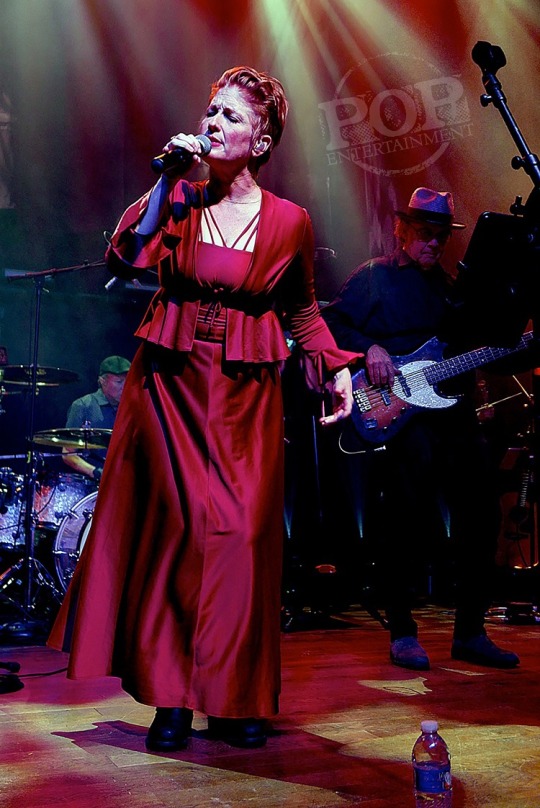
10,000 Maniacs with Leigh Nash – Ardmore Music Hall – Ardmore, PA – November 12, 2023
10,000 Maniacs was briefly – during the mid-late 1980s and early 1990s – one of the biggest bands in the alt-rock world. Formed in Johnstown, New York in the early 80s and fronted by singer/songwriter Natalie Merchant, with keyboardist Dennis Drew, bassist Steve Gustafson, drummer Jerry Augustyniak and guitarist Robert Buck, they broke out with their 1986 album In My Tribe, which spawned three minor hits – “Like the Weather,” “What’s the Matter Here” and a cover of Cat Stevens’ “Peace Train,” but eventually sold over 2,000,000 copies.
In 1989 their follow-up Blind Man’s Zoo opened up their recognition even more, becoming a platinum record (1,000,000 units sold) and they just missed the top 40 with their single “Trouble Me.” Their 1992 album Our Time In Eden also became a hit, spawning the minor hits “These Are Days” and “Candy Everybody Wants.” However, they had their first top 10 single with a live cover of Patti Smith’s “Because the Night,” which was recorded for MTV Unplugged, back in the days where nearly every band released an Unplugged album.
Right at the height of their fame, Merchant decided to leave the band to go solo, a sporadically successful venture which led to a couple of big hit albums and has continued to this day. The band’s label Elektra decided to stick with Merchant and drop the rest of the band. Therefore, in regrouping, the Maniacs brought on board John Lombardo (who had been an early member of the group but left the album before they broke out) and his musical partner Mary Ramsay, who had a folk band called John and Mary which had opened for the Maniacs. (Both had performed as part of the Maniacs at the MTV Unplugged session.)

Over the years since, the band had a series of lineup changes – the most important one coming when guitarist and songwriter Robert Buck died way too young of liver disease at age 42 in 2000 – but basically the band continued on with a base of Drew, Gustafson, Augustyniak and Lombardo. Ramsay ended up having a much longer run with 10,000 Maniacs than Merchant ever did – recording four albums (10 if you count EPs and live albums), and even having a fluke top 40 hit with a cover of Roxy Music’s “More Than This” on her first album with the band, and touring with the band for nearly 30 years before leaving the group last year.
Without a singer for the first time in decades – I don’t know if they reached out to Merchant, but she is still working on her solo career and has shown little interest in looking backwards over the years – the band had an interesting thought. Over the years they had toured periodically with the group Sixpence None the Richer – which was big in the late 90s and early 00s and had hits with “Kiss Me,” “Breath My Name” and covers of the La’s “There She Goes” and Crowded House’s “Don’t Dream It’s Over.” The members of 10,000 Maniacs became friends with the band, particularly singer Leigh Nash and lead guitarist and songwriter Matt Slocum. Why not bring them onboard, and the tour can be a mixture of both groups’ hits? (The group’s official bio promoting this tour is a bit vague as to whether Nash and Slocum have joined 10,000 Maniacs full time or if this is just a one-tour thing…)
It turns out to be a pretty good fit. Nash’s vocals are similar enough to Merchant and Ramsay’s so as to not be distracting, and yet different enough to add a bit of interest and excitement to songs that have been around for decades.

This gig was the second of two shows on the tour in the Philadelphia area. The night before the new Maniacs played at the more traditional Colonial Theater in nearby Phoenixville, about a half-hour drive away. The Ardmore Music Hall is more of a large club, standing-room-only atmosphere.
The band opened with a slightly more obscure tune, “City of Angels,” but after that there was a run of hits that lasted most of the first set. (The show was broken into two nine-song sets plus a three-song encore.) “Trouble Me” started things off with a sweet hopefulness before the set took a slightly darker turn... at least lyrically. “What’s the Matter Here?” and “Like the Weather” (undoubtedly two of the most upbeat and catchy songs ever written about the serious subjects of child abuse and manic depression) from In My Tribe still feel new, immediate and wonderful all these years after their release.
The covers also started to pop up soon afterwords, with gorgeous takes on “Don’t Dream It’s Over” and “More Than This” going down smoothly. Back to the originals, the political treatise “You Happy Puppet” still stings in its immediacy – in fact it’s perhaps even more trenchant today than it was when originally recorded. The first set finished off on the gorgeously somber “Stockton Gala Days.”
The mix of the groups was even more evident in the second act, when 10,000 Maniacs’ desperate “Don’t Talk” was followed up by Sixpence’s wonderfully catchy “Breath My Name.” (That song should have been a much bigger hit than it became.) Of course, each of the bands’ biggest hits were represented: from 10,000 Maniacs’ propulsive cover of Patti Smith and Bruce Springsteen’s biting romantic discourse “Because the Night” to the sweetly naïve and lovesick catchiness of Sixpence’s near-perfect hit single “Kiss Me.”
That romanticism was also touched on in a couple of favorite In My Tribe album tracks, the sweetly charming marriage song “My Sister Rose” and the beat-generation mythologizing of “Hey Jack Kerouac,” which led into the encore. The group sent the night out with the perfect power pop of The La’s “There She Goes” and then closed things out with an uplifting version of “These Are Days.”
Turns out that the merging of two separate popular bands from two different eras worked out pretty well in this case. I’m looking forward to seeing if this collaboration goes further.
Jay S. Jacobs
Copyright ©2023 PopEntertainment.com. All rights reserved. Posted: November 14, 2023.
Photos by Jim Rinaldi © 2023. All rights reserved.
0 notes
Text
Change the F*cking Channel
This one is kind of... well... VERY political and I will make no apologies. We’re living in a time where simply being human is political. If you don’t think so, you haven’t been paying attention. And you NEED to pay attention.
There is an amazing podcaster by the name of Micah Hanks. While better known for his eponymous show centering on UFO/UAP phenomenon, he did have a great current events podcast called Middle Theory which I have binged a few times. One of the recurring themes on the show was the issue of “cancel culture” and... yeah... I have things to say on the subject.
No, I’m not taking Mr. Hanks on. On the contrary, we’re very much of a similar mind on the topic. Mr. Hanks, in my opinion, expressed the pitfalls of cancel culture rather sensibly and eloquently. I just want to take a few moments to share my feelings on it.
I was born in 1980. If you remember the 1980s, you remember that it was the “liberal” left declaring war on music and video games. (Take a breath. I’m a Progressive Liberal, so you’re not gonna be getting MAGA bullshit. And if you want MAGA bullshit... go somewhere else.) Tipper Gore, Al’s missus, is the reason why nearly every album in my metalhead kid brother’s CD collection had a parental advisory label. It’s been “liberals” decrying simulated violence in video games for violent actions among young people. (Not, of course, addressing issues like home life, mental health issues, bullying, etc.)
Now, it wasn’t just the left, of course. Who could forget the late Jerry Falwell’s homophobic crusade against the Teletubbies? And, as a child of the 80s, I clearly recall conservatives losing it over shows like He-Man, She-Ra, Rainbow Bright, The Care Bears, The Smurfs, and my personal favorite, Captain Planet and the Planeteers. Why? These shows promoted tolerance, inclusion, environmentalist ideologies and, in the case of Captain Planet, Neopaganism. They weren’t wrong about that, but being a Wiccan kid, that’s why I loved this stuff. But, you know, you can’t promote tolerance and inclusion because that’s a threat to “traditional values”. (Translation: Christian values)
Back in the 80s and 90s, when both sides were being painfully stupid about what American kids should and should not be allowed to consume, the general public seemed to have the same attitude. If you don’t like it, don’t consume it.
What the ever-loving fuck happened? Look, most reasonable people can agree that there are some ideas that are harmful. Calling for violence against any individual or group is bad, regardless of how you might feel about them. Hate-speech is unacceptable at any time. However, due to the 24 hours news cycle and it’s 10 second sound bites as well as the proliferation of social media, there is no room for nuanced discussion. Some public figure says something that gave you boo-boos on your feelings, cancel them.
Like I said, I consider myself to be a Progressive Liberal, but I come from a more moderate/centrist time. I come from a time when it was possible to have well reasoned and measured dialogue about opposing viewpoints. I come from a time when the fringe elements didn’t have 24/7 platforms to barf up their conspiracy theories or their anti-whatever manifestos. I come from a time when schools promoted critical thinking. *sigh* Those were the days...
Obviously, we had people try to limit what could and could not be disseminated, but we had ways around it. If you remember the 90s, you know it was all about independent media. Independent music labels, pirate radio, independent coffee shops with open mic nights, zines... man, I miss my teens! This was how Generation X and “Elder Millennials” got by the censorship. And now... they support censorship because that was cancel culture is.
Let me give you all a little more perspective. My parents were Boomers. When they were kids, there were only 3 broadcast television networks and a handful of AM/FM radio stations. Print media was how most people consumed the daily news and news media was forbidden to report on anything BUT the news. No pundits pontificating and giving their opinions. They just gave you the facts. (It would be great if we could get back to that.) When my parents were young, the married couples could not share a bed in films or television. Lucille Ball broke ground for women’s rights when she refused to hide her pregnancy on her show, “I Love Lucy”. (She also helped get Star Trek made, so praise her name, nerds.)
Compare that to today. We have hundreds of thousands of podcasts spanning just as many genres and topics. Mr. Hanks has half of them! (I tease with love. He only had 3... for now.) Broadcast television is almost dead, but it’s still out there with hundreds of channels and then you have the growing number of video streaming services. Social media is.. well, it’s a cesspool, but it’s there. We are in a time where we actually have too many options for our entertainment and for our information. And yet... one show, one person, one song, one “something” sets off a small demographic and everyone has to come out in force and demand that he/she/it/they get “canceled”. Why? Change the fucking channel. Find something else. You have the freedom to choose... just like everyone else.
Alright, I’m done. End rant.
0 notes
Text
Ap hourly news

and around the. Get in-depth enterprise reporting from across the U.S. Read, watch and listen to news stories by our Spectrum News journalists and local partner publications. Our global journalists and reporters are the first to break the worlds stories. Spectrum News ofrece historias e información que te importan tanto a ti como a tu comunidad. Petros Giannakouris/AP Show More Show Less 2 of 18. Ben & Jerry’s also claimed the deal violated the 2000 acquisition agreement that allowed Ben & Jerry’s to continue its progressive social mission independent of business decisions made by Unilever. Spectrum News provides stories and information that matter to you and your community. 1 of 18 The Sturgeon moon rises behind a replica of an ancient bronze statue of Zeus or Poseidon, in Corinth, Greece, on Friday, Aug. In its suit, Ben & Jerry’s argued the move by Unilever “poses a risk” to the integrity of its brand. Last year Ben & Jerry’s independent board said it was going to stop selling its ice cream in the Israeli-occupied West Bank and contested east Jerusalem, saying the sales in the territories sought by the Palestinians are “inconsistent with our values.”Įarlier this year, Unilever announced that it was selling its business interest in Ben & Jerry’s in Israel to its Israeli licensee, which would market the products with Hebrew and Arabic labels. In the aftermath of the 2020 death of George Floyd, Ben & Jerry’s became an advocate for Black Lives Matter. That activism continued after it was purchased by Unilever in 2000 with the focus on, among other issues, migrant justice and climate change. nuclear weapons spending in the 1980s, and in the 1990s, supporting LGBTQ+ rights and farmers. Similar "Flagship Check-In" areas already exist in Los Angeles and Miami, with another opening this summer in Chicago.Ben & Jerry’s spokesman Sean Greenwood said Monday that the company had “no new position for us to share at this time.”īen & Jerry’s complaint in the case filed last month outlined the company’s tradition of social activism over its 44-year history, including opposition to U.S. 000,006, by the valuation contract, ap. The airline also unveiled a new VIP check-in area at JFK Wednesday to ease its top customers and first class transcontinental passengers through the airport. The wage accepted, counterproposals of the company, brings the hourly wage to 66. That way coach passengers no longer walk through first class on their way back to their seats, giving first class passengers more privacy. Vahidi would not say what routes would be eliminated.Īmerican will also allow boarding through the second door on these planes. In order to increase Los Angeles service, the airline will have to cut elsewhere. Airlines are limited in the number of daily takeoffs and landings at JFK. Exclusive Canadian provider of 24/7 AP world news: With over 50 Pulitzer Prizes, APs journalists are the first to break the worlds stories, which are only available in Canada through CP. The new planes have nearly a third of their seats in business or first class. The high frequency is favored by business travelers who pay higher fares for last-minute tickets. JetBlue and Virgin America also offer non-stop flights. The route is the most competitive domestically, with Delta and United fighting with American for corporate contracts.

1 note
·
View note
Text

-A Mitsubishi F-2A on the runway at Anderson AFB on Guam for an exercise. | Photo: USAF
FLIGHTLINE: 170 - MITSUBISHI F-2
Developed from the Lockheed F-16, the F-2 is a multirole aircraft in the Japanese Air Self-Defense force, replacing the Mitsubishi F-1 in the 1980s.
In the early 1970s the JASDF began acquiring the F-1 ground attack/anti-shipping aircraft based on the Mitsubishi T-2 supersonic trainer. The F-1 served Japan well through rest of the 1970s, but by 1981 a replacement was being contemplated, with a formal study being initiated in 1985. The Japanese government, defense agencies and contractors were all highly desirous of the new aircraft being designed and built domestically in order to grow the Japanese aviation industry. US officials, meanwhile, became concerned that an internally designed and manufactured aircraft could be of inferior quality, and might in fact damage US-Japan relations. A co-produced, or at least co-developed, alternative based on the American F-16 or F/A-18 were proposed by the Pentagon instead; pressure against Japan for this bilateral development project increased as mid-80s 'Japan-bashing' peaked with the Toshiba-Kongsberg Scandal, in which it was discovered that Toshiba sold propeller milling machinery to the Soviet Union in violation of sanctions. After months of negotiations, a joint project to develop and produce the new aircraft was announced by the Regan and Nakasone administrations. Later revisions to the MOU restricted Japanese access to flight and weapons control software and ensured that any new technology developed during the project was shared with the US.
AGILE FALCONS, INTERNATIONAL COOPERATION
One of the variants of the F-16 explored but not produced was the so-called "Agile Falcon", which would have had had a larger wing, more powerful engines, as well as extensive avionics upgrades, color displays, an electronic warfare management system, reconnaissance pods, AIM-9X Sidewinder infrared air-to-air missile integration, and helmet-mounted sights. The aircraft was offered to the USAF as a low-cost alternative to the ATF program, as well as to NATO allies as a competitor to the SAAB Gripen or Dassault Rafale, but there was no interest in the plane. General Dynamics resurrected the idea as a starting point for the new JASDF strike fighter, variously designated FS-X or SX-3. The basic wing and fuselage designs remained the same, but the engines and avionics were updated and Japanese-made components were substituted whenever possible. Costs for the FS-X were split 60/40 between Japan and the US. In 1992 General Dynamics' aviation division was sold to Lockheed, making the latter company the prime US contractor. Lockheed Martin supplied the aft fuselage, leading-edge slats, stores management system, a large percentage of wingboxes, and other components. Kawasaki built the midsection of the fuselage, as well as the doors to the main wheel and the engine, while the forward fuselage and wings were built by Mitsubishi. Some of the avionics were supplied by Lockheed Martin, and the digital fly-by-wire system was jointly developed by Japan Aviation Electric and Honeywell (formerly Allied Signal). Contractors for communication systems and IFF interrogators included Raytheon, NEC, Hazeltine, and Kokusai Electric. The fire control radar, IRS, the mission computer, and the EW system were developed by Japan. In addition, the flight control computer, the flight control laws and related computer software were essentially all developed and integrated by Japan. Final assembly was done in Japan, by MHI at its Komaki-South facility in Nagoya.

-Top-down silhouettes of the F-16C and F-2A, showing the differences in size and configuration of the two aircraft. | Illustration: 坊主
DESIGN AND SPECIFICATIONS
Although based on the F-16, more than 95% of the Falcon's engineering drawings were changed for the F-2. The wings of the new plane were 25% larger, with thee skin, spars, ribs and wing caps were made from graphite/epoxy composite in order to cut down on weight. In addition to the larger wing and tail, the nose is longer and wider to accommodate the J/APG-1 active electronically scanned radar (AESA) (the F-2 was the first operational military aircraft to carry one, beating the F-22 Raptor). The intake was also enlarged, feeding more air into a GE F110 turbofan. The F-16's single piece bubble canopy was changed to a three piece unit. The F-2 is equipped with a drogue parachute, similar to one fitted to certain export models of the F-16. Given its multi-mission role within the JASDF, the F-2 is capable of carrying four ASM-1 or -2 anti-ship missiles, free-fall bombs (with or without imaging infra-red seekers), JDAM bombs, JLAU-3/A rocket pods, and AAM-3, -4, -5, AIM-9 or AIM-7 air-to-air missiles. FLIR and Sniper laser-designation pods can also be fitted. A 20mm cannon is also carried.
Two models of the F-2 have been produced, the F-2A single seat model and the F-2B trainer, though both are the same dimensions. F-2s are 15.52m long, with a wingspan of 11.125m (10.8m not counting wingtip missile rails) and the wing has an area of 34.84m2. Max TO weight is 22,100kg, including 4,600l of fuel (just less than 4,000l for the F-2B). Combat range of the F-2 is 833km, increasable with drop tanks or aerial refueling. Maximum speed of the F-2 is Mach 1.7 at high altitude, and max ceiling is 18,000m.

-Orthograph of the F-2A. | Illustration: Dr. Dan Saranga
PRODUCTION AND INTRODUCTION
Maiden flight of the F-2 was on 7 October 1995, with four prototypes and two static test airframes completed. An initial order for 141 aircraft was signed in 1995, but this was later cut to 130, with deliveries completed by 1999. Structural deficiencies in the prototypes delayed introduction until 2000. During this time, the order was cut again, down to 98 aircraft (including the four prototypes). The last F-2 was delivered on 27 September 2011, at which point Mitsubishi closed the line. F-2s were delivered to five squadrons or groups within the JASDF, the first being the Air Development and Test Wing at Gifu AB.

-The first XF-2A (originally 63-0001, now 63-8501) continues to be flown by ADTW. | Photo: JASDF
Training is conducted by the 21st Fighter Training Squadron, 4th Air Wing, at Matsushima AB. As a result of the 2011 earthquake and tsunami, 13 of the 21 F-2Bs assigned to the 21st were damaged, and 5 destroyed. Repairs to the F-2s was completed by 2016, and was estimated at 80 billion JPY. Two other F-2Bs have been destroyed in accidents, one in 2007 as a result of faulty wiring after a refurbishment and a second in 2019 for reasons that have not been released.

-An F-2B in flight. | Photo: Jerry Gunner

-4 of the F-2Bs from the 21st breaking formation. | Photo: Cp9asngf
There are three operational units of the F-2A: the 3rd Tactical Fighter Squadron, 3rd Air Wing at Misawa AB, and the 6th and 8th TFS, 8th Wing at Tsuiki AB. In addition to strike missions, the F-2 has proved to be adept at interception and escort missions, as the JASDF proved in 2013 when 4 F-2s were scrambled to intercept a pair of Russian Air Force Su-27s near Hokkaido on 7 February 2013. On 22 August 2013 F-2s were again scrambled to intercept two Tu-142 Bear-F aircraft near Kyushu.

-F-2A of the 3rd TFS during the 2007 Open House at Hyakuri AB. | Photo: A&W

-An F-2A demonstrates the type's ability to refuel in mid-air from a JASDF KC767 during an airshow at Komaki AB in 2018. | Photo: Hunini

-An F-2A armed with four ASMs. | Photo: JASDF
THE FUTURE
The F-2 is scheduled to be replaced by the Mitsubishi F-X (unofficially known as the F-3 Godzilla) some time in the mid-2030. The F-X will be a sixth generation, domestically developed stealth aircraft, currently anticipated to have its maiden flight in 2028.

-Rendering of the F-X, Japan's next fighter. | Illustration: 防衛省
#aircraft#aviation#avgeek#airplanes#airplane#aviation history#jasdf#Japanese air self defense force#mitsubishi heavy industries#Mitsubishi f-2#f2a#f2b#Mitsubishi f 2#f16#f 16
38 notes
·
View notes
Video
undefined
tumblr
Dick Grayson timeline
Also known as the list I started trying to get the pictures in my 80-year anniversary video in the right order. I have skipped a lot of video games, and a number of Elseworld comics and I have not included for instance every Teen Titans/Titans title Dick has ever been in. And, of course, it does not include every story arc, retelling of Dick’s history or single issue he’s been in. (This video and timeline are reposted for technical reasons...)
1940. Dick Grayson / Robin debuts in Detective Comics # 38. (April issue, but it was released earlier. I have seen both March 5 and 6 named as release date and I’ve also read that this is an approximation. Evidently, the delivery date varied greatly back in the days.)
1943. Movie serial The Batman with Douglas Croft as Robin.
1943. October 25. Publication start of the daily comic strip Batman and Robin. Ends in 1946.
1945. (March.) Batman and Robin’s first appearance in the radio show The Adventures of Superman, with Ronald Liss as Robin.
1947. (February.) The first Robin solo series starts in Star Spangled Comics # 65. Robin - The Boy Wonder (sometimes with the addition of Batman) would continue in SSC until the title ended in July 1952, # 130.
1949. Movie serial The New Adventures of Batman and Robin, with Johnny Duncan as Robin.
1950. Robin’s first outing as Batman (with a Robin symbol instead of a Bat) in DC # 165.
1952. Superman # 76. The first time Batman and Superman meet in comics (it ends with Robin taking Lois Lane to dinner.)
1954. Batman, Robin and Superman team up for the first time in World’s Finest Comics # 71.
1964. First appearance of what would become the Teen Titans, in The Brave and the Bold #54.
1966. Batman: The Movie and the tv show. Burt Ward as Robin.
1966. May 29. Publication start of the daily comic strip Batman with Robin the Boy Wonder. It ends in 1969.
1966. A manga adaptation of Batman is published in Japan, with Jiro Kuwata as main artist. The manga is published 1966-1967 and adapts Silver age Batman stories.
1966. Teen Titans vol 1.
1967. First appearance of Robin of Earth-Two, in Justice League of America #55. (He was considered to be the Dick Grayson from the ”Golden age” stories. As an adult, he was a member of the Justice Society of America, a lawyer, ambassador, and attorney. He went out as Batman once in his career.)
1969. (December.) Dick moves from Gotham to Hudson university in ”One bullet too many!”, Batman # 217. Bruce and Alfred leaves Wayne Manor. Robin will have sporadic solo stories in the Bat titles until the early 1980s.
1972. Batman and Robin in The New Scooby-Doo movies with Casey Kasem voicing Robin.
1973. The Super Friends, animated television series with Batman and Robin and other superheroes. Produced by Hanna-Barbera. Casey Kasem is voice actor for Robin.
1976 (to 1981). The comic book Super Friends adapted the adventures from the television animated series.
1977. The New Adventures of Batman, animated, with Burt Ward as Robin.
1978. Teen Titans vol 1 ends.
1980. (October.) Dick leaves Hudson university, resigned to the fact that he can’t continue as Robin and keep up with college. In ”The Gotham Connection”, in Detective Comics #495.
1980. The New Teen Titans. (# 1 in November.)
1980. (December.) Dick comes to Gotham in Batman # 330. Bruce is disappointed he has left college.
1982. Bruce, Alfred and Dick moves back to Wayne Manor and the Batcave, in Batman # 348.
1984. Dick decides to stop calling himself Robin in Tales of the Teen Titans # 39 (February).
1984. Dick gives Jason Todd his old Robin suit in Batman # 368 (February).
1984. Dick becomes Nightwing in Tales of the Teen Titans #44 (July).
1985-1986. Crisis on Infinite Earths. Earth-Two is erased from continuity. However, that world’s Dick Grayson (still using the name Robin) and Helena Wayne (Huntress), did not perish with their world since they were in the battle against the Anti-Monitor. They were killed and buried at Valhalla Cemetery on the remaining Earth.
1987. The Crisis catch up with Batman with a new version of how Dick left Robin, and a new origin story for Jason Todd, in Batman # 408 (June).
1989. Batman Year Three. Storyline in Batman # 436-439.
1989. In the story arc A Lonely place of Dying, Dick becomes the new co-owner of Haly circus and low-key supports Tim Drake as a new Robin.
1990. The Batman Murders, a novel written by Craig Shaw Gardner with Dick/Nightwing as a prominent character. It takes place in a timeline similar to the comics at the time, after Jason’s death but before Tim.
1992. There were plans for writer/artist Art Thibert to write a miniseries together with Pamela Winesette that would start around New Titans # 93 and end with Dick and Starfire getting married (in New Titans # 100). An editorial shift in DC resulted in the plans being scrapped.
1992. Batman The Animated Series. Loren Lester as Robin.
1992. The Batman Adventures. Tie-in comic to BTAS. Ends in 1995.
1994. KnightsEnd Prodigal. Dick’s first longer stint as Batman, with Tim as Robin.
1995. TAS game.
1995. Nightwing Alfred’s return.
1995. Batman & Robin Adventures, tie-in to BTAS. Ends in 1997.
1995. Batman Forever, with Chris O’Donnell as Dick.
1995. Nightwing vol 1, a 4 issue mini series.
1996. Dick Grayson is Moonwing, agent of S.H.I.E.L.D. in Bruce Wayne, Agent of S.H.I.E.L.D. Moonwing is an amalgamation of Marvel’s Moon Knight and DC’s Nightwing in the Amalgam Universe.
1996. Shadow of the Bat Annual # 4, a medieval fantasy AU where Bruce is the king hiding in his castle while Dick fights in his place as Batman (and is killed).
1996. Nightwing vol 2. Dick moves to Blüdhaven in # 1.
1996. Kingdom Come. Dick is Red Robin and has a daughter, Mar’i, with Starfire.
1997. Batman & Robin. Chris O’Donnell as Dick.
1997. Batman and Captain America. (Earth-3839)
1997. Nightwing Annual # 1. Dick pretends to marry a woman to investigate if she has murdered previous husbands.
1997. The Batman Chronicles: The Gauntlet.
1997. Thrillkiller. Elseworld story.
1998. Batman & Mr Freeze: SubZero. Loren Lester as the voice of Dick/Robin.
1998. The Batman Adventures. The Lost Years. 5 issue mini-series, BTAS Dick leaves Gotham, at odds with Batman, and Robin. He travels the world to learn. When he finally returns, he has transformed to Nightwing.
1998. Batman: Gotham Adventures. Continuing BTAS comic, with Dick as Nightwing and Tim as Robin. Ends in 2003.
1998-1999. Batman: Dark Knight of the round table. Elseworld story.
1999. Dick joins the Blüdhaven Police Academy in Nightwing # 32, planning to fight the corruption from the inside.
1999. Dark Victory.
1999. The Kingdom. Sequel/prequel to Kingdom Come.
1999 (-2004). Superman and Batman: Generations. (Earth-3839 again)
2000. Dick gets a job as a cop in Blüdhaven, in Nightwing # 48.
2001. Dick is Batman (and is killed ) in Superman and Batman: Generations # 2.
2001. Robin Year One.
2001. Dick is adopted in the main continuity, in Batman: Gotham Knights # 21.
2001. JLA: Riddle of the Beast. Elsworld story (a fantasy story where Batman keeps Nightwing’s dead body sitting beside him on the throne).
2001–2002. Batman: The Dark Knight Strikes Again, by Frank Miller and more. Dick Grayson, who used to be Robin but was abused and sacked by Batman, has become a Joker-like character, an insane criminal with a healing factor and shape-shifting abilities. In the end, he is killed by Batman.
2002. Batman: Nine lives. Elseworld story. (Set in Gotham in the 1940s, Dick Grayson is a private detective.)
2002. Nightwing becomes the leader of a new line-up of the JLA in the storyline The Obsidian Age (JLA # 69). The former members have disappeared but Batman had a contingency plan: a new team lead by Nightwing.
2003. Teen Titans (tv). Scott Menville as Robin.
2003. Donna Troy is (seemingly) killed in Titans/Young Justice: Graduation day. Nightwing declares that ”The Titans are finished”.
2003. Dick becomes leader of the Outsiders in Outsiders vol 3 # 1. He’s been persuaded by Roy Harper/Arsenal, who claims this team will not be a family, only co-workers.
2003. Dick is fired from the police force in Nightwing # 83, when Police Captain Amy Rohrbach, Dick’s former partner, realizes he is Nightwing.
2003. Batman Adventures vol 2. New tie-in comic to BTAS, where Dick/Nightwing makes the occasional appearance. Ends in 2004.
2004. DC: The New Frontier by Darwyn Cooke.
2004. The Batman Strikes. Tie-in comics to the animated tv show The Batman, where Dick will turn up in 2006 (and in # 29, 2007). Ends in 2008.
2005. First issue of Frank Miller’s All Star Batman & Robin, the Boy Wonder.
2005. Year One: Batman/Scarecrow.
2005. Nightwing Year One. Storyline in Nightwing # 101-106.
2006. Infinite Crisis. Blüdhaven is destroyed by a gang of supervillains who drop the radioactive Chemo over the city, as vengeance against Nightwing. There were plans to kill Dick in Infinite Crisis, but DC changed their minds and he was badly hurt instead.
2006. Nightwing starts operating in New York in Nightwing # 118.
2006. Batman/The Spirit.
2006. "Inheritance", a novel by former Nightwing and Batman-writer Devin Grayson. It revolves around three superheroes and their former sidekicks – Batman and Nightwing, Green Arrow and Arsenal and Aquaman and Tempest. (I haven’t read this myself, but from what I’ve seen her take on Dick – and Bruce’s and Dick’s relationship – is pretty controversial among fans.)
2006. Dick makes his debut in the animated The Batman (2004). Robin is voiced by Evan Sabara. In the episode ”Artifacts”, an older Dick as Nightwing is voiced by Jerry O’Connell.
2007. Dick steps down as leader of the Outsiders. Batman takes over and tells him ”Go back to the good fight, Dick. Leave the bad fight to us.”
2008. Tiny Titans.
2008. Justice League: The New Frontier. Animated movie adaptation of Darwyn Cooke’s limited series.
2008. Dick becomes curator of The Cloisters in New York, in Nightwing # 141.
2008. Dick Grayson of Earth-43. (Countdown Presents: The Search for Ray Palmer: Red Rain # 1.)
2009. NightLantern/Hal Grayson, an amalgam of Dick and Hal Jordan in a dream world created by Doctor Destiny. Superman/Batman # 60-61.
2009. Nightwing vol 2 ends. Dick moves back to Gotham after Bruce’s ”death”.
2009. Batman: Battle for the Cowl. 3 issues. Jason wants to take over as a more violent Batman, he shoots Damian and leaves Tim for dead before Dick, who is reluctant to put on the cowl, defeats him.
2009. Batman: The Widening Gyre. 6 issue series that was supposed to have a continuation. Dick is Robin (and younger Nightwing) in flashbacks and Nightwing in the present. An elseworld where Bruce is set to marry Silver StCloud, but the flashbacks borrow a lot from canon stories.
2009. Li’l Gotham.
2009. Dick makes his debut as Batman in Batman #687.
2009. Batman & Robin vol 1, with Dick as Batman and Damian as Robin.
2009. Dick/Robin appears in the episode ”The Color of Revenge” of Batman: The Brave and the Bold. Dick is voiced by Crawford Wilson.
2010. Young Justice (tv). Robin is voiced by Jesse McCartney.
2010. Batman: Under the Red Hood. Dick/Nightwing is voiced by Neil Patrick Harris.
2010. Dick appears in the episode ”Sidekicks Assemble” of Batman: The Brave and the Bold. Young Robin is voiced by Jeremy Shada, older Robin/Nightwing by Crawford Wilson.
2010. Dick appears in Batman Beyond (with an eye patch), vol 3, Hush Beyond. This Hush turns out to be a clone of Dick, made by Amanda Waller to have someone to replace Bruce as Batman if needed.
2011. Flashpoint.
2011. Flashpoint: Deadman and the Flying Graysons. A mini-series with an alternate university where Dick ends up as the new Doctor Fate.
2011. Nightwing vol. 3. (New 52) When the series start, Dick has moved to his own place in Gotham after having filled in as Batman for ”almost a year”. (Before Flashpoint, he was Batman for more than a year.)
2011. In Batman Beyond vol 4, Dick has a small part in issue 4. There he goes public with that he was Nightwing and claims he was a paid employee and never saw Batman without a mask. (He is not on speaking terms with Bruce.)
2011. Batman Live, stage show with Kamran Darabi-Ford and Michael Pickering as Dick.
2011. Batman: Arkham City. Dick/Nightwing makes no-speaking appearance in the game.
2011. The Court of Owls, storyline i Batman vol 2 about a secret organization that will later be revealed to have ties to Dick’s family.
2012. Young Justice season 2, Dick has become Nightwing, voiced by Jesse McCartney.
2012. Holy Musical B@man. (March 22-25, at Hoover-Leppen Theatre in Chicago, Illinois.) Nick Lang as Robin.
2012. ”The Gray Son” in Nightwing vol 3 # 9. The Grayson family gets a new origin story with the Court of Owls.
2013. Batman Beyond 2.0, where Dick works with Terry McGinnis/Batman.
2013. Dick moves to Chicago in Nightwing vol 3 # 19, following the trail of Tony Zucco, the man who killed his parents.
2013. Batman ’66, comic book continuation of the tv show from 1966.
2013. Arkham Origins (game). Josh Keaton is voice actor for Dick/Robin.
2013. Injustice: Gods Among Us, a video game, Troy Baker as voice actor.
2013. Nightwing is killed in the game tie-in comic Injustice: Gods Among Us #16.
2013. Teen Titans Go. Scott Menville is voice actor for Robin.
2014. In Batman Beyond 2.0 # 17-24, we get a glimpse of an alternate Dick, in the Justice Lord’s timeline, married to Barbara and where they have a son, John.
2014. Nightwing vol 3 ends.
2014. Forever Evil, where Lex Luthor kills Dick to stop a bomb, wired to his heart, to explode. But revives him (possibly only because Batman attacks him).
2014. Grayson. Batman has (pretty much forced) Dick to pretend to remain dead and infiltrate the organisation Spyral.
2014. Son of Batman (DC AMU). Sean Maher is the voice of Dick/Nightwing.
2014. Earth 2: World’s end. On this earth, Dick and Barbara are married and have a son, John. The world is destroyed and Barbara is killed. Dick, who was a reporter, lets John go so the boy can be saved on a spaceship but Dick eventually ends up with Batman, Thomas Wayne, and gets away from the doomed planet.
2014. Nightwing: The Series, a fan-made live action webb-series produced by Ismahawk, with Danny Shepherd as Dick/Nightwing.
2015. Titans Hunt.
2015. Batman vs. Robin (DC AMU). Sean Maher is the voice of Dick/Nightwing.
2015. Arkham Knight (game). Scott Porter is the voice actor for Dick/Nightwing.
2015. Batman: Arkham Knight. Limited series, a prequel to the game. Dick makes a blink-and-you-miss-it appearance.
2015. Batman & Robin Eternal.
2015. Batman Unlimited, a series of direct-to-video animated films (Animal Instincts (May 2015), Monster Mayhem (August 2015) and Mechs vs. Mutants (September 2016) ) and online-shorts inspired by the action figure line produced by Mattel. Dick is Nightwing.
2015. Convergence. DC event featuring characters from earlier continuities. It consist of a main miniseries as well as a number of 2 issue miniseries. In the main story, Dick from Earth 2 teams up with Batman/Thomas Wayne. When they visit the Batcave of pre-Flashpoint Batman Alfred offers Dick a cup of Earl Grey. After Thomas Wayne hs been killed, Dick decides to continue in his footsteps. This story continues in Earth 2: Society.
2015. Convergence: Nightwing/Oracle. 2 Pre-Flashpoint characters, the story ends with Dick and Barbara marrying.
2015. Convergence: The New Teen Titans. NTT from the time of Crisis on Infinite Earths. Dick is married to Koriand’r/Starfire.
2015. Convergence: Detective Comics. Dick Grayson/Robin and Helena Wayne/Huntress of the old Earth-Two are forced to fight Superman Red Son. The story ends with Dick putting on Batman’s suit. (This Dick and Helena were earlier killed in Crisis on Infinite Earths #12 in 1986.)
2015. Dick is the Batman in Earth 2: Society, a continuation of Earth 2: World’s End.
2016. Batman: Bad Blood (DC AMU) Dick/Nightwing is voiced by Sean Maher.
2016. Batman Beyond 2.0 ends. Dick and Bruce seem to reconcile.
2016. Grayson ends.
2016. Nightwing vol 4 (Rebirth).
2016. Return of the Caped Crusaders. Burt Ward as the voice of Dick/Robin.
2016. Superman American Alien # 4, where a young Dick makes an appearance.
2016. Dick moves to Blüdhaven in (Rebirth) Nightwing # 10.
2016. Batman /TMNT Adventures.
2016. Titans (Rebirth comics, discontinued 2019).
2017. Teen Titans: The Judas Contract (DC AMU). Dick/Nightwing is voiced by Sean Maher.
2017. The Lego Batman movie. Michael Cera is the voice of Dick/Robin.
2017. Batman/Teenage Mutant Ninja Turtles II.
2017. Batman: White Knight.
2017. Batman vs. Two-Face. Burt Ward is the voice of Dick/Robin.
2017. Batman and Harley Quinn. Loren Lester is the voice of Dick/Nightwing.
2017. Batman and Harley Quinn. 7 issue comic.
2017. Nightwing: The New Order. Dick and Starfire have a son, Jake, in a future where Dick as Nightwing had used a device to nullify superpowers, believing it was the best way to save humanity.
2018. Teen Titans Go. To the Movies. Scott Menville is Dick/Robin.
2018. Dick appears in Batman Beyond (2016) vol 6 # 25. This is another version than in earlier Batman Beyond, he has both his eyes, a beard and a daughter, Elainna. Dick is the mayor of Blüdhaven.
2018. Batman # 55 (September). Dick is shot in the head and the amnesiac Ric storyline begins. He supposedly tries to build a new life in Blüdhaven, away from the Wayne’s and superheroing, while the name Nightwing is used by three cops and a firefighter; however, Dick is soon out fighting crime again.
2018. Titans (tv). Brenton Thwaites is Dick Grayson/Robin.
2018. Batman Ninja. Daisuke Ono is the voice actor for Nightwing.
2018. Batman/Teenage Mutant Ninja Turtles II.
2018. Batman: Gotham by Gaslight. Lincoln Melcher is the voice actor for Dickie.
2019. Young Justice: Outsiders. Dick/Nightwing is voiced by Jesse McCartney.
2019. Richard "Dick" Grayson / Robin, the leader of the Tween Titans and adopted son of Bruce Wayne in the animated show DC Super Hero Girls. Debuted in From Bat to Worse (July, 2019) Voice actor Keith Ferguson.
2019. Batman: Hush. (DC AMU). Sean Maher is the voice actor for Dick.
2019. Batman: Last Knight on Earth (where Dick for a time goes by Talon, because the bats were defeated, and he and Barbara have a daughter, Bryce).
2019. DCeased, where Dick is one of the first to succumb to the virus.
2019. Batman: Curse of the White Knight.
2019. Lego DC Batman: Family matters. Will Friedle is the voice actor for Dick/Nightwing.
2019. Tales from the Dark Multiverse. Teen Titans The Judas Contract. Dick and all the other Titans, heroes and most of humanity (I think) are killed by Terra.
2019. Teen Titans Go! vs Teen Titans. Scott Menville is the voice of both Robins.
2019. Nightwing has a small part in the novel “The Court of Owls” by Greg Cox (Titan book).
2019. The Court of Owls have given Dick false memories after he was shot in the head, and he is dressed up as a Talon for a while in the Nightwing comic.
2019. Batman/Teenage Mutant Ninja Turtles III.
2019. Batman: Curse of the White Knight. Sequel to Batman: White Knight
2019. Dick (Brenton Thwaites) becomes Nightwing in the last episode of season 2 of Titans.
2020. In the regular Nightwing title, Dick starts to regain his true memories. However, when this is being written, Coronavirus and DC events make it unsure when we’ll get the real Dick back.
2020, March 18. Robin 80th Anniversary special.
2020. Batman: The Adventures Continue. (The continued adventures of BTAS in comic books.)
2020: Dick appears in Titans: Titans Together, as well as Batman: Gotham Nights. Digital comics that seem to take place outside the main continuity.
2020. Justice League Dark: Apokolips War (DC AMU). (Nightwing is killed, Damian tries to revive him in a Lazarus pit but his mind never heals.)
2020. Dick regains his memories in Nightwing vol 4 # 74 (September 8), 720 days after he lost them in Batman vol 3 # 55. He gets back into his Nightwing suit in Batman vol 3 # 99.
2021. In the DC possible future-event Future State (January-February 2021), Dick is in two books: Nightwing and Teen Titans.
2021. Dick gets himself a thre-legged puppy in Nightwing vol 4 # 78. Fans in the USA could vote and she got the name Haley (alias Bitewing).
2021. After the relaunch Infinite Frontier, parts of Dick’s pre-Flashpoint history in Blüdhaven has been restored. He has for instance been a cop, and lives in the apartment building he bought during Nightwing vol 2.
2021. In the title Teen Titans Academy, which seems to be a prequel to Future State: Teen Titans, Dick is one of the mentors for a new generation of Titans. Dick also makes appearances in for instance Future State: Gotham, The Batman & Scooby-Doo Mysteries and has a story in Batman: Black & White (2020) # 5.
2021. Dick is Police Commissioner of Gotham in Batman/Catwoman, a 12 issue Black Label miniseries written by Tom King.
2021. Season 3 of Titans.
2021. Dick is an adorable Robin from an alternate universe in Batman/Robin (2019) # 16–21 plus Annual # 1, written by Gene Luen Yang.
2021, September. Batman: Wayne Family Adventures, comic at Webtoon. A fanon-friendly take where Wayne Manor is filled to the brim with (more or less) adopted junior vigilantes.
2021. Injustice: Gods Among Us animated movie, Dick is in there to die and become the new Deadman, I guess. Voice actor Derek Phillips.
2021. Yoshi Sudarso was supposed to be Nightwing/Dick Grayson in a live-action mini-series adaptation of the fanon-friendly webtoon Batman: Wayne Family Adventures by Ismahawk. But after the news broke, it seemed to be stuck in limbo.
2021. Young Justice: Phantoms. Season 4 of the animated show on HBO Max in October.
2021, November. Robin and Batman, a three issue miniseries written about Dick’s first time as Robin. Writer Jeff Lemire, art Dustin Nguyen.
2021. Batman vs Bigby! A Wolf in Gotham. A Batman/Fables crossover limited series where (as far as I understand) everyone stays as a Robin, including Dick.
2021. DC vs Vampires. A 12 issue limited series. In #6 (2022), Nightwing is showed to be the Vampire king and kills several of his family on panel.
2021, September. Batman: The Audio Adventures. Melissa Villase˜njor is voice actor for Robin.
2021, November. Robins, six issue miniseries written by Tim Seeley, the winner of DC’s Round Robin contest.
2021, November. Dark Knights of Steel, Fantasy AU written by Tom Taylor, art by Yasmine Putri. Nightwing/Dick is one of “Batman’s” Robins in this the world.
2021. Nightwing is annoounced as a playable character in the Gotham Knights game, together with Red Hood, Robin (Tim) and Batgirl (Barbara). Voice actor Christopher Sean. The game was published in 2022.
2022. Dick is Robin in Batman/Superman: World’s Finest, stories from the past that are tied to the current continuity via Batman vs. Robin and Lazarus Planet.
2022. Batman: Beyond the White Knight. Sequel to Batman: White Knight and Curse of the White Knight. It is revealed (unless it was in an earlier book) that Jason Todd was the first Robin and Dick was the second.
2022. In the comic book Future State Gotham, Dick used the enhancing drug Brane to gain an edge in the fight against the Magistrate and assorted villains. It enhanced his intelligence and gave him some precognition. He also started to use a Batman-like suit. In the end (#18), Dick sacrifices himself to destroy the ghost of Joe Chill, who had possessed Damian. (🤷♀️ Yeah, I know, I wouldn’t pay to read that...)
2022. Dark Crisis on Infinite Earths # 1-7. The Justice League is presumed dead (Nightwing seems to be sure they will come back) and super criminals attack en masse. Along the way, “the Great Darkness” tries to take Nightwing as its new host but he fights it off. At the end of the event, the Justice League disband.
2022. Nightwing is a character in the third season of the animated Harley Quinn on HBO Max, with Harvey Guillen as voice actor.
2022. Batman: Gotham Knights – Gilded city. A tie-in prequel to the video game Gotham Knights.
2022. Titans United: Bloodpact. Limited series, set in its own universe as far as I can see.
2023. Batman: The Doom that came to Gotham. Animated movie adaptation of Elseworld comic book from 2000, that takes place in the 1920s. Jason Marsden is voice actor for Dick Grayson.
2023. World’s Finest: Teen Titans. A spin-off from Batman/Superman: World’s Finest.
2023. Titans, a new comic book about the Titan’s residing in Blüdhaven and functioning as the prime superhero team.
139 notes
·
View notes
Photo
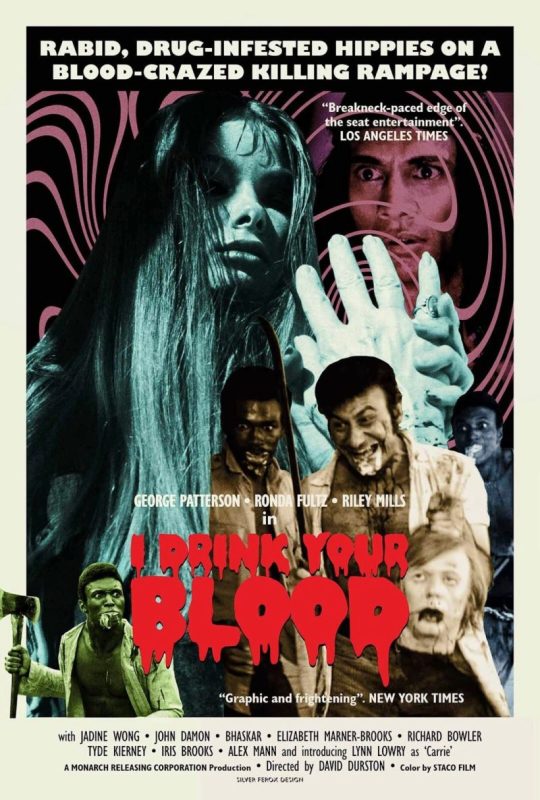
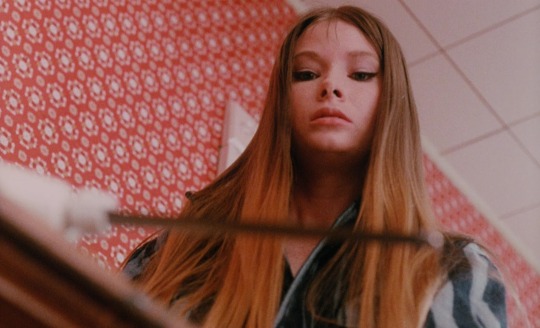

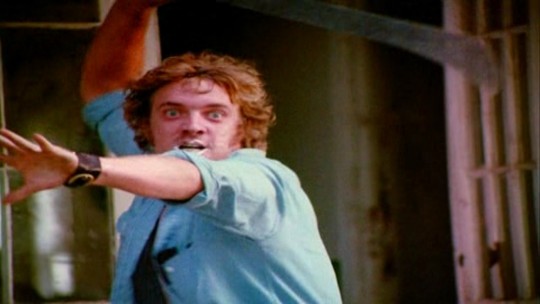
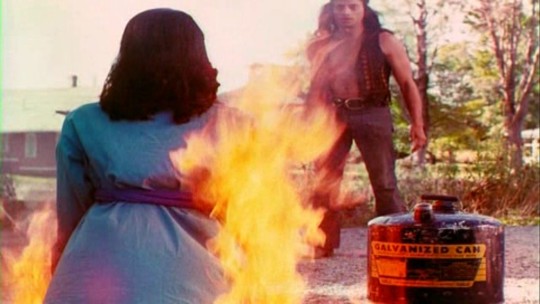


I Drink Your Blood (1971) full review
Published by grimoireofhorror.com 13/01/21
B-movies have become a staple in popular culture over the recent years, with cult classics from the 1970s and 1980s finally receiving the wider attention they rightly deserve. One such classic piece of media that has garnered attention is I Drink Your Blood.
I Drink Your Blood (1971) is an exploitation film directed by David Durston, who has only directed a total of 7 films from 1964 to 1978, including Stigma (1972) and produced by Jerry Gross, who has work on a number of well-known films such as Zombie Flesh Eaters (1979) (or Zombi 2, depending on where you are from).
*This review contains spoilers
The film opens to Horace, the leader of a roaming cult of satanic hippies, performing an occult ritual in the woods outside of a small town, when a young girl, Sylvia, is noticed observing the group, but Andy, a young man, who she had caught stealing a chicken in the afternoon and befriended, tries to defend her. The rest of the group give chase and attack her, beating her mercilessly. After managing to make her way back into town the next morning, she is found traumatized by her younger brother, Pete, and Mildred, the towns baker, who take her home to her grandfather, the local vet.
After their van breaks down, the cult has no choice but to make their way into town for supplies. They buy food from Mildred, who is unaware of what has transpired, who lets them know that the town is scheduled for demolition and they can stay in a vacated house for the night.
After Sylvia overcomes her state of shock, she tells her grandfather what has happened and he confronts the cult, only to be beaten and force-fed LSD. As Horace is about to kill the old man, the cult members convince him to stop as Pete arrives outside, demanding to know what is going on. Angered by what the cult did to his family, Pete hatches a plan of revenge by obtaining tainted blood from a rabid dog to lace food to sell to the cult.
After eating the contaminated food, except for Andy, who refuses to eat, the cult starts to show signs of infection and exhibit violent behaviour, causing some of them to flee into the night. One member of the group is picked up by construction workers from the local dam, who take her back to their lodgings to calm down, she proceeds to have sex with a few of the workers and infect them. Roger, head of site construction and Mildred’s boyfriend, discovers his workforce are now all infected with rabies and is chased, along with the local doctor, down to a lake filled quarry but their assailants are scared away by the water that has collected.
The remaining members of the cult attack each other in what remains of the town whilst Pete, Sylvia and Andy, who has expressed regret for what had happened to Sylvia, try to find a means of escape. The group find Mildred hidden inside the bakery, but as they are let inside, Andy is attacked and killed by a rabid construction worker and the store is breached but Mildred manages to kill one as they escape outside to her car. Surrounded by Rabid workers and cultists, the car is flipped over and all looks lost until a group of armed police, led by Robert, gun down the remaining infected and save the trio from harm.
The film was originally title Phobia but was changed after production to be more fitting for a double feature and renamed I Drink Your Blood to be paired with I Eat Your Skin, a film that went by the name Zombie and was shelfed for 6 years before Jerry Gross obtained the rights to release the film under this double feature.
The film was the first to receive an X rating for violence alone and was re-edited and scenes reshot to receive a M rating and a cinema release. It is rumoured that David Durston based the character of the cult leader, Horace, on actual cult leader Charles Manson, who was made famous for ordering his cult to go on a killing spree in 1960’s California. With the film being marketed and released a year after Manson’s conviction, Jerry Gross wanted to cash in on the public’s fascination and disgust with the case. In 2009, David announced that he planned to remake the film, which he had started work on the films script, unfortunately, David’s death in 2010 has causes the project to be permanently shelved.
The cinematography is fairly competent but has many scenes where crew members are visible making them feel somewhat rushed in production. The use of its soundtrack adds both tension and unintended comedy to certain scenes, composed by Clay Pitts, the synth heavy soundtrack being atmospheric and unsettling in some scenes but becomes hilarious during chase scenes. The practical special effects are very well done for such a small budget and hold up 50 years later, with great blood work and realistic props, it’s one of the films core strengths. I’m not going to lie; this film was never going to win any awards. With a fine mix of over and under acting by the cast of relatively unknown actors, a campy exploitation story and unique 70’s soundtrack, this film falls perfectly into the category of “so bad its good”, and my is it good.
Despite all this, the film has positive to mixed reviews from critics and is a beloved cult classic, having similar characteristics to later classics as David Cronenberg’s Rabid (1977) and George A Romero’s The Crazies (1973) and has been shown at frequently at film festivals over the years, helping cement its place in popular culture.
#writing#writers on tumblr#journalsim#journal#review#exploitation#film#b movies#i drink your blood#gore#zombies#the banshee#grimoire of horror
9 notes
·
View notes
Text
LIZ LEARNS TO DRIVE
November 13, 1948

“Liz Learns To Drive” (aka “Liz's Driving License” and “Liz Learns to Drive”) is episode #16 of the radio series MY FAVORITE HUSBAND broadcast on November 13, 1948.
Synopsis ~ George teaches Liz to drive and she immediately gets in an accident. Through a communications mix-up, George thinks Liz has intentionally run over George's high school sweetheart, Myra Ponsenby!
Note: This episode was aired before the characters names were changed from Cugat to Cooper. It was also before Jell-O came aboard to sponsor the show and before the regular cast featured Bea Benadaret and Gale Gordon as the Atterburys.
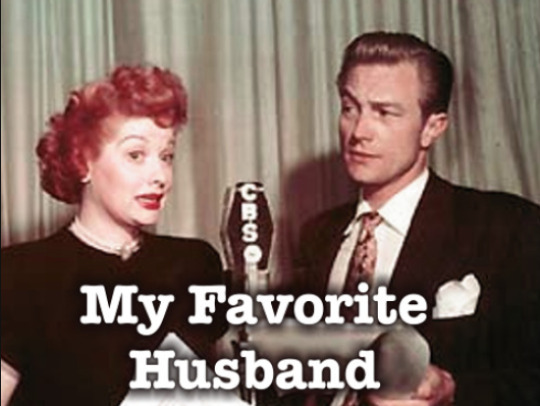
“My Favorite Husband” was based on the novels Mr. and Mrs. Cugat, the Record of a Happy Marriage (1940) and Outside Eden (1945) by Isabel Scott Rorick, which had previously been adapted into the film Are Husbands Necessary? (1942). “My Favorite Husband” was first broadcast as a one-time special on July 5, 1948. Lucille Ball and Lee Bowman played the characters of Liz and George Cugat, and a positive response to this broadcast convinced CBS to launch “My Favorite Husband” as a series. Bowman was not available Richard Denning was cast as George. On January 7, 1949, confusion with bandleader Xavier Cugat prompted a name change to Cooper. On this same episode Jell-O became its sponsor. A total of 124 episodes of the program aired from July 23, 1948 through March 31, 1951. After about ten episodes had been written, writers Fox and Davenport departed and three new writers took over – Bob Carroll, Jr., Madelyn Pugh, and head writer/producer Jess Oppenheimer. In March 1949 Gale Gordon took over the existing role of George’s boss, Rudolph Atterbury, and Bea Benaderet was added as his wife, Iris. CBS brought “My Favorite Husband” to television in 1953, starring Joan Caulfield and Barry Nelson as Liz and George Cooper. The television version ran two-and-a-half seasons, from September 1953 through December 1955, running concurrently with “I Love Lucy.” It was produced live at CBS Television City for most of its run, until switching to film for a truncated third season filmed (ironically) at Desilu and recasting Liz Cooper with Vanessa Brown.
MAIN CAST
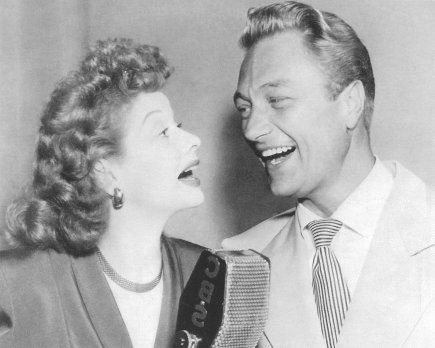
Lucille Ball (Liz Cugat) was born on August 6, 1911 in Jamestown, New York. She began her screen career in 1933 and was known in Hollywood as ‘Queen of the B’s’ due to her many appearances in ‘B’ movies. “My Favorite Husband” eventually led to the creation of “I Love Lucy,” a television situation comedy in which she co-starred with her real-life husband, Latin bandleader Desi Arnaz. The program was phenomenally successful, allowing the couple to purchase what was once RKO Studios, re-naming it Desilu. When the show ended in 1960 (in an hour-long format known as “The Lucy-Desi Comedy Hour”) so did Lucy and Desi’s marriage. In 1962, hoping to keep Desilu financially solvent, Lucy returned to the sitcom format with “The Lucy Show,” which lasted six seasons. She followed that with a similar sitcom “Here’s Lucy” co-starring with her real-life children, Lucie and Desi Jr., as well as Gale Gordon, who had joined the cast of “The Lucy Show” during season two. Before her death in 1989, Lucy made one more attempt at a sitcom with “Life With Lucy,” also with Gordon.
Richard Denning (George Cugat) was born Louis Albert Heindrich Denninger Jr., in Poughkeepsie, New York. When he was 18 months old, his family moved to Los Angeles. Plans called for him to take over his father’s garment manufacturing business, but he developed an interest in acting. Denning enlisted in the US Navy during World War II. He is best known for his roles in various science fiction and horror films of the 1950s. Although he teamed with Lucille Ball on radio in “My Favorite Husband,” the two never acted together on screen. While “I Love Lucy” was on the air, he was seen on another CBS TV series, “Mr. & Mrs. North.” From 1968 to 1980 he played the Governor on “Hawaii 5-0″, his final role. He died in 1998 at age 84.
Ruth Perrott (Katie, the Maid) was also later seen on “I Love Lucy.” She first played Mrs. Pomerantz, a member of the surprise investigating committee for the Society Matrons League in “Pioneer Women” (ILL S1;E25), as one of the member of the Wednesday Afternoon Fine Arts League in “Lucy and Ethel Buy the Same Dress” (ILL S3;E3), and also played a nurse when “Lucy Goes to the Hospital” (ILL S2;E16). She died in 1996 at the age of 96.
Bob LeMond (Announcer) also served as the announcer for the pilot episode of “I Love Lucy”. When the long-lost pilot was finally discovered in 1990, a few moments of the opening narration were damaged and lost, so LeMond – fifty years later – recreated the narration for the CBS special and subsequent DVD release.
GUEST CAST

John Hiestand (Cory Cartwright) served as the announcer for the radio show “Let George Do It” from 1946 to 1950. In 1955 he did an episode of “Our Miss Brooks” opposite Gale Gordon.

Bea Benadaret (Woman Driver) was considered the front-runner to be cast as Ethel Mertz but when “I Love Lucy” was ready to start production she was already playing a similar role on TV’s “The George Burns and Gracie Allen Show” so Vivian Vance was cast instead. On “I Love Lucy” she was cast as Lucy Ricardo’s spinster neighbor, Miss Lewis, in “Lucy Plays Cupid” (ILL S1;E15) in early 1952. Later, she was a success in her own show, “Petticoat Junction” as Shady Rest Hotel proprietress Kate Bradley. She starred in the series until her death in 1968.

Frank Nelson (Officer Frank Nelson) was born on May 6, 1911 (three months before Lucille Ball) in Colorado Springs, Colorado. He started working as a radio announcer at the age of 15. He later appeared on such popular radio shows as “The Great Gildersleeve,” “Burns and Allen,” and “Fibber McGee & Molly”. Aside from Lucille Ball, Nelson is perhaps most associated with Jack Benny and was a fifteen-year regular on his radio and television programs. His trademark was playing clerks and other working stiffs, suddenly turning to Benny with a drawn out “Yeeeeeeeeees?” Nelson appeared in 11 episodes of “I Love Lucy”, including three as quiz master Freddy Fillmore, and two as Ralph Ramsey, plus appearance on “The Lucy-Desi Comedy Hour” - making him the only actor to play two different recurring roles on “I Love Lucy.” Nelson returned to the role of the frazzled Train Conductor for an episode of “The Lucy Show” in 1963. This marks his final appearance on a Lucille Ball sitcom.

Herb Vigran (Sergeant Martin Lewis, Homicide Squad) made several appearances on “My Favorite Husband.” He would later play Jule, Ricky’s music union agent on two episodes of “I Love Lucy”. He would go on to play Joe (and Mrs. Trumbull’s nephew), the washing machine repairman in “Never Do Business With Friends” (S2;E31) and Al Sparks, the publicity man who hires Lucy and Ethel to play Martians on top of the Empire State Building in “Lucy is Envious” (S3;E23). Of his 350 screen roles, he also made six appearances on “The Lucy Show.”
The name Martin Lewis may be a tribute to the comedy team of Dean Martin and Jerry Lewis, who first performed together in 1946, and went their separate ways ten years later.
THE EPISODE
ANNOUNCER: “It is morning, and Katie the maid has just put breakfast on the table and Liz and George are sitting down to it.”
George is reluctant to read the paper at the table after Liz’s previous chastisement about ignoring her at breakfast. This time, she encourages him to pick up the newspaper and when he does, she has torn a hole through the center so she can see him and he can read the news!
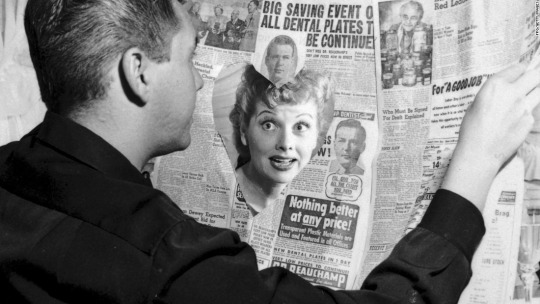
Lucy Ricardo also had the same complaint about Ricky on “I Love Lucy”!
LIZ: “I’m looking at you through an automobile ad. The new Nash has blue eyes for headlights. And your ears look like both doors are wide open.”
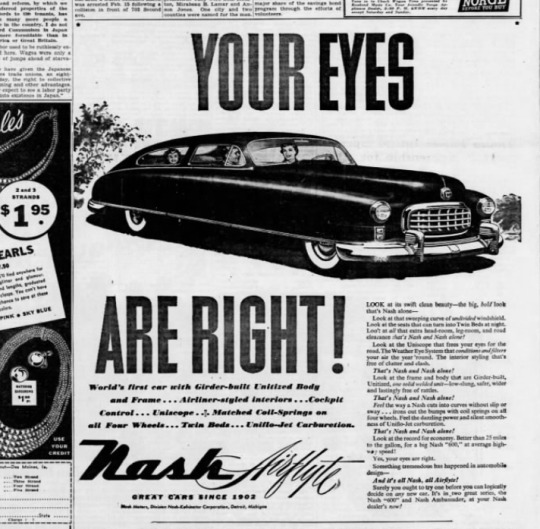
Nash Motors Company was an American automobile manufacturer based in Kenosha, Wisconsin, from 1916 to 1957. In 1938 Nash debuted the heating and ventilation system which is still used today. The aerodynamic 1949 Nash Airflyte was the first car of an advanced design introduced by the company after the war. Nash went out of business in February 1954.
Katie says she had the same problem with her first husband, Clarence. As a last resort, she set his newspaper on fire!
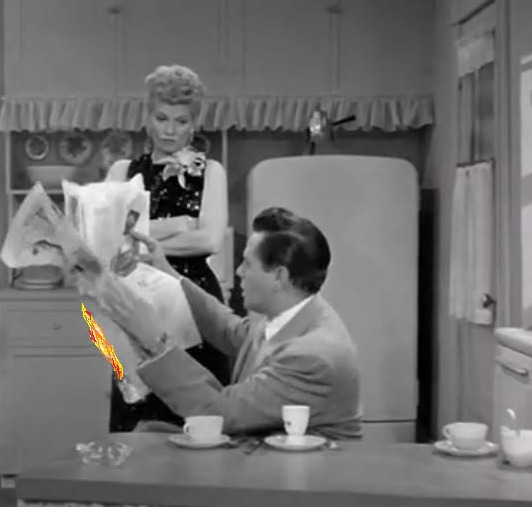
In “Be A Pal” (ILL S1;E2), Lucy also tries setting fire to the newspaper to get her husband’s attention! Considering all the trouble Desi had to assure the studio audience’s safety for the Los Angels Fire Department, it is amazing this stunt was allowed!
Through his ‘holy’ newspaper, George reads about his old college girlfriend, Myra Ponsenby. Liz is unenthusiastic.
LIZ: “What’s new in Lower Slobbovia?”
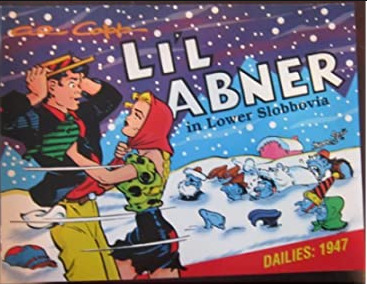
In “First Stop” (ILL S4;E14) Fred Mertz calls One Oak Cabins “Lower Slobbovia,” which is a term first used in 1946 by Al Capp in his comic strip "Li'l Abner” to describe a place that was unenlightened and socially backward.
Liz is clearly jealous and wishes Myra would “drop dead” claiming there isn’t room enough for the both of them in town. George says the article claims she is driving into town in her new imported car called a Zebra [a fictional car].
LIZ: “I’m glad she’s got a car. It was dangerous riding around on that broomstick.”
Myra is married to Mr. Minky the peanut king, who Liz insists she married for his money. Tired of hearing about Myra, Liz begs George for another driving lesson. The last time he gave her a lesson she drove their Hudson into someone’s kitchen!

The Hudson Motor Car Company made automobiles in Detroit, Michigan from 1909 to 1954. In 1954, Hudson merged with Nash-Kelvinator to form American Motors Corporation (AMC). The Hudson name was discontinued in 1957.
George gives in and promises to give her a lesson on the back roads after work. When he gets home, she tells him she practiced before he got there, but forgot to open the garage door! Liz finally finds the starter (after trying the cigarette lighter and the radio). Then she has trouble finding the clutch. George is foaming at the mouth in anxiety.
Liz finally gets the car on the road - but the wrong side! They nearly have a collision! George gets frustrated and Liz dissolves into tears.

Much of the driving lesson dialogue and situations were recycled in the episode “Safe Driving Week” in October 1950. In it, George is elected town Safety Chairman just when Liz creates havoc on the roads.
Later, Cory Cartwright volunteers to help Liz pass her driving test. He wishes her luck, as she goes into the police station to get her driver’s license.
NELSON: “Name?”
LIZ: “Elizabeth Cugat.”
NELSON: “Address?”
LIZ: “321 Bundy.”
NELSON: “Race?”
LIZ: “Of course not! I don’t even have a driver’s license!”
After much rhetorical to-ing and fro-ing, he takes her fingerprints and gives her the eye test:
NELSON: “Read the letters on the wall over there.”
LIZ: “M-E-N.”
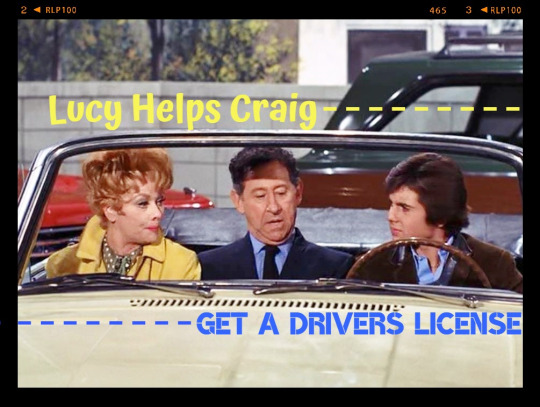
The eye test and fingerprinting that Liz undergoes are repeated when Lucy Carter helps her son Craig get a license in a 1969 episode of “Here’s Lucy.”
Somehow Liz passes the driving test and gets her license. Naturally she gets in an accident on the way home with Cory. The car is a wreck, but they are okay. The other driver is a woman (Bea Benadaret) who says she will call her lawyer and the police.
Liz doesn’t know what she will say to George about the damage to the car. Cory agrees to help her get it fixed before George finds out.

When “Lucy Learns To Drive” (ILL S4;E12) in 1955, she also has an accident after her first lesson. Like Liz, she has to come up with a story so that her favorite husband doesn’t get angry!
When Liz finally gets home, George tells her that Myra Ponsenby has been reported missing. Liz couldn’t care less, but George wants to know why she’s so late home and is acting so peculiar. The phone rings and George eavesdrops on her conversation about the car. Not knowing to whom or what she’s talking about, George believes that his wife has done away with Myra!
LIZ (on the phone): “You know how George feels about that old wreck. That wasn’t the first time she’d been hit. Did you see all those dents in her trunk? And her rear bumper was in pretty bad shape, too. Wasn’t it awful? I thought she’d never stop yelling. And all I did was hit her with the front wheels.”

An overheard telephone conversation on the very first filmed “I Love Lucy” episode in 1951 convinces Lucy that Ricky is going to murder her! Of course, Ricky is merely talking about ‘getting rid’ of his girl singer, Joanne.
George, thinking Liz is a murderer, emerges from hiding to confront her. Clueless, Liz doesn’t know what all the fuss is about, but George is sure she will ‘get the chair’! Just then the doorbell rings and it is Sergeant Lewis (Herb Vigran), of the homicide squad. A worried Liz hides in the kitchen while George answers the door. After a moment of doubt, Liz decides to give herself up. She tells the Sergeant to arrest her!
Down at the police station, Liz is confronted by the policeman who issued her driver’s license, who has now transferred to homicide. The questions he asks mirror those of the driving test earlier in the day. Liz decides to tell him the whole story, thinking she’s confessing to a traffic accident and not a murder!
NELSON: “What did you do with the body?”
LIZ: “I had them jack it up and haul it away on a truck.”
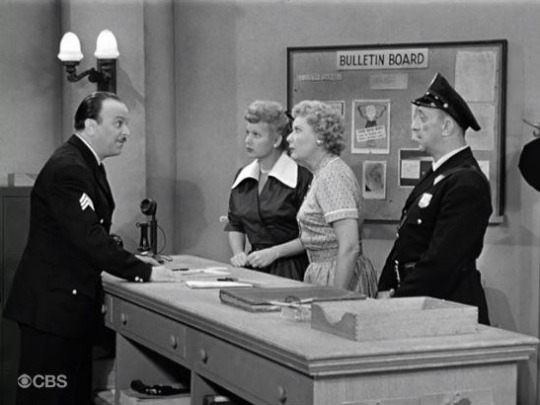
Frank Nelson also played a policeman named Nelson in “Ricky and Fred Are TV Fans” (ILL S2;E30) in 1953. In it, Lucy and Ethel are mistaken for Sticky Fingers Sal and Pickpocket Pearl. The dialogue is different, but also features rapid fire questions and answers between Ball and Nelson.
The telephone rings and it is announced that Myra Ponsenby has been found alive! She was in jail after speeding through a small town and arrested.
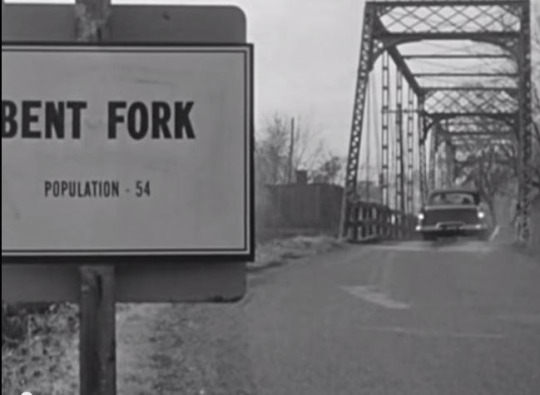
In “Tennessee Bound” (ILL S4;E15) new driver Lucy Ricardo also sped through a small town (Bent Fork) and was arrested!
After a moment, Liz suddenly realizes that that they assumed she murdered Myra! Liz laughs, knowing that she will now get the car fixed without any fuss!

In the usual bedtime tag, Liz is up late reading a murder mystery. George spoils the ending so he can get some sleep: the butler did it. George says the butler killed his wife because she talked too much when he was trying to go to sleep!
LIZ: “Ohhhh! Goodnight, George.”
#My Favorite Husband#Lucille Ball#Richard Denning#Bea Benadaret#Frank Nelson#Herb Vigran#radio#1948#CBS#Bob Lemond#I Love Lucy#Here's Lucy#Driving Test#Hudson Cars#Li'l Abner#Nash Automobiles#John Hiestand
4 notes
·
View notes
Photo
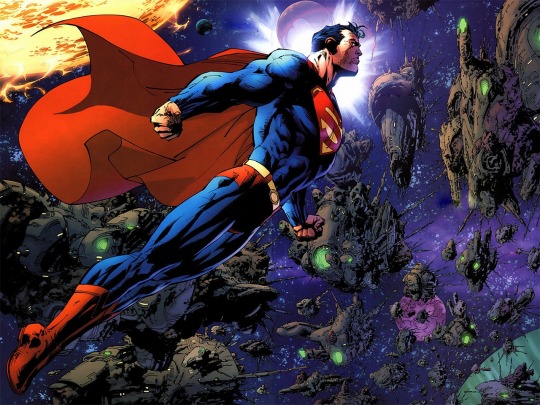
Superman
Superman is a fictional superhero, who first appeared in American comic books published by DC Comics. The character was created by writer Jerry Siegel and artist Joe Shuster, and first appeared in the comic book Action Comics #1 (cover-dated June 1938 and published April 18, 1938). Superman has been adapted to a number of other media including radio serials, novels, movies, television shows and theatre.
Superman was born on the planet Krypton and was given the name Kal-El at birth. As a baby, his parents sent him to Earth in a small spaceship moments before Krypton was destroyed in a natural cataclysm. His ship landed in the American countryside, near the fictional town of Smallville. He was found and adopted by farmers Jonathan and Martha Kent, who named him Clark Kent. Clark developed various superhuman abilities, such as incredible strength and impervious skin. His adoptive parents advised him to use his abilities for the benefit of humanity, and he decided to fight crime as a vigilante. To protect his privacy, he changes into a colorful costume and uses the alias "Superman" when fighting crime. Clark Kent resides in the fictional American city of Metropolis, where he works as a journalist for the Daily Planet. Superman's supporting characters include his love interest and fellow journalist Lois Lane, Daily Planet photographer Jimmy Olsen and editor-in-chief Perry White. Superman has an extensive Rogues Gallery with his arch-enemy being supervillain Lex Luthor.
Although Superman was not the first superhero character, he popularized the superhero archetype and established its conventions. Superheroes are usually judged by how closely they resemble the standard set by Superman. He was the best-selling superhero character in American comic books up until the 1980s.
> Clark Kent
Superman's secret identity is Clark Joseph Kent, a reporter for the Daily Planet. Although his name and history were taken from his early life with his adoptive Earth parents, everything about Clark was staged for the benefit of his alternate identity: as a reporter for the Daily Planet, he receives late-breaking news before the general public, has a plausible reason to be present at crime scenes, and need not strictly account for his whereabouts as long as he makes his story deadlines. He sees his job as a journalist as an extension of his Superman responsibilities—bringing truth to the forefront and fighting for the little guy. He believes that everybody has the right to know what is going on in the world, regardless of who is involved.
To deflect suspicion that he is Superman, Clark Kent adopted a largely passive and introverted personality with conservative mannerisms, a higher-pitched voice, and a slight slouch. This personality is typically described as "mild-mannered", perhaps most famously by the opening narration of Max Fleischer's Superman animated theatrical shorts. These traits extended into Clark's wardrobe, which typically consists of a bland-colored business suit, a red necktie, black-rimmed glasses, combed-back hair, and occasionally a fedora. Clark wears his Superman costume underneath his street clothes, allowing easy changes between the two personae and the dramatic gesture of ripping open his shirt to reveal the familiar "S" emblem when called into action. His hair will also change with the costume change, with Superman sporting a small curl or spit curl on his forehead. Superman usually stores his Clark Kent clothing compressed in a secret pouch within his cape, though some stories have shown him leaving his clothes in some covert location (such as the Daily Planet storeroom) for later retrieval.
As Superman's alter ego, the personality, concept, and name of Clark Kent have become ingrained in popular culture as well, becoming synonymous with secret identities and innocuous fronts for ulterior motives and activities. In 1992, Superman co-creator Joe Shuster told the Toronto Star that the name derived from 1930s cinematic leading men Clark Gable and Kent Taylor, but the persona from bespectacled silent film comic Harold Lloyd and himself. Clark's middle name is given variously as either Joseph, Jerome, or Jonathan, all being allusions to creators Jerry Siegel and Joe Shuster.
> Personality
In the original Siegel and Shuster stories, Superman's personality is rough and aggressive. He often uses excessive force and terror against criminals, on some occasions even killing them. This came to an end in late 1940 when new editor Whitney Ellsworth instituted a code of conduct for his characters to follow, banning Superman from ever killing. The character was softened and given a sense of humanitarianism. Ellsworth's code, however, is not to be confused with "the Comics Code", which was created in 1954 by the Comics Code Authority and ultimately abandoned by every major comic book publisher by the early 21st century.
In his first appearances, Superman was considered a vigilante by the authorities, being fired upon by the National Guard as he razed a slum so that the government would create better housing conditions for the poor. By 1942, however, Superman was working side-by-side with the police. Today, Superman is commonly seen as a brave and kind-hearted hero with a strong sense of justice, morality, and righteousness. He adheres to an unwavering moral code instilled in him by his adoptive parents. His commitment to operating within the law has been an example to many citizens and other heroes, but has stirred resentment and criticism among others, who refer to him as the "big blue boy scout". Superman can be rather rigid in this trait, causing tensions in the superhero community. This was most notable with Wonder Woman, one of his closest friends, after she killed Maxwell Lord. Booster Gold had an initial icy relationship with the Man of Steel, but grew to respect him.
Having lost his home world of Krypton, Superman is very protective of Earth, and especially of Clark Kent's family and friends. This same loss, combined with the pressure of using his powers responsibly, has caused Superman to feel lonely on Earth, despite having his friends and parents. Previous encounters with people he thought to be fellow Kryptonians, Power Girl (who is, in fact from the Krypton of the Earth-Two universe) and Mon-El, have led to disappointment. The arrival of Supergirl, who has been confirmed to be not only from Krypton, but also his cousin, has relieved this loneliness somewhat. Superman's Fortress of Solitude acts as a place of solace for him in times of loneliness and despair.
> Powers, abilities, and weaknesses
Since Action Comics #1 (1938), Superman has superhuman strength. The cover of Action Comics #1 shows him effortlessly lifting a car over his head. Another classic feat of strength on Superman's part is breaking steel chains. In some stories, he is strong enough to shift the orbits of planets and crush coal into diamond with his hands.
Since Action Comics #1 (1938), Superman has a highly durable body, invulnerable for most practical purposes. At the very least, bullets bounce harmlessly off his body. In some stories, such as Kingdom Come, not even a nuclear bomb can harm him.
In some stories, Superman is said to project an aura that renders invulnerable any tight-fitting clothes he wears, and hence his costume is as durable as he is despite being made of common cloth. This concept was first introduced in Man of Steel #1 (1986). In earlier stories, Superman's costume is made out of exotic materials that are as tough as he is.
In Action Comics #1, Superman could not fly. He traveled by running and leaping, which he could do to a prodigious degree thanks to his strength. Superman gained the ability to fly in the second episode of the radio serial in 1940. Superman can fly at great speeds. He can break the sound barrier, and in some stories, he can even fly faster than light to travel to distant galaxies.
Superman can project and perceive X-rays via his eyes, which allows him to see through objects. He first uses this power in Action Comics #11 (1939). Certain materials such as lead can block his X-ray vision.
Superman can project beams of heat from his eyes which are hot enough to melt steel. He first used this power in Superman #59 (1949) by applying his X-ray vision at its highest intensity. In later stories, this ability is simply called "heat vision".
Superman can hear sounds that are too faint for a human to hear, and at frequencies outside the human hearing range. This ability was introduced in Action Comics #11 (1939).
Since Action Comics #20 (1940), Superman possesses superhuman breath, which enables him to inhale or blow huge amounts of air, as well as holding his breath indefinitely to remain underwater or space without adverse effects. He has a significant focus of his breath's intensity to the point of freezing targets by blowing on them. The "freezing breath" was first demonstrated in Superman #129 (1959).
Action Comics #1 (1938) explained that Superman's strength was common to all Kryptonians because they were a species "millions of years advanced of our own". In the first newspaper strips, Jor-El is shown running and leaping like Superman, and his wife survives a building collapsing on her. Later stories explained they evolved superhuman strength simply because of Krypton's higher gravity. Superman #146 (1961) established that Superman's abilities other than strength (flight, durability, etc.) are activated by the light of Earth's yellow sun. In Action Comics #300 (1963), all of his powers including strength are activated by yellow sunlight and can be deactivated by red sunlight similar to that of Krypton's sun.
Exposure to green kryptonite radiation nullifies Superman's powers and incapacitates him with pain and nausea; prolonged exposure will eventually kill him. Although green kryptonite is the most commonly seen form, writers have introduced other forms over the years: such as red, gold, blue, white, and black, each with its own effect. Gold kryptonite, for instance, permanently nullifies Superman's powers but otherwise does not harm him. Kryptonite first appeared in a 1943 episode of the radio serial. It first appeared in comics in Superman #61 (Dec. 1949).
Superman is also vulnerable to magic. Enchanted weapons and magical spells affect Superman as easily as they would a normal human. This weakness was established in Superman #171 (1964).
4 notes
·
View notes
Text
THE HISTORY OF THE H-DIAL, DC’S WEIRDEST SUPERHERO CONCEPT
Everyone wants to be Superman. His unparalleled might, massive array of powers, and winning personality makes him a fantasy figure in many imaginations. But if we’re being honest with ourselves, given the option, we wouldn’t want to be one superhero, we’d want to be all of them. This is the premise behind Dial H for HERO’s H-Dial, an incredibly powerful object used in DC Comics stories intermittently since the 1960s.
Introduced in House of Mystery #156 (a title up to that point reserved for supernatural horror stories), the H-Dial was discovered by teenager Robby Reed in a cavern while he was camping nearby. The H-Dial resembles a rotary phone dial, and since Robby existed in a time when rotary phones were still in use (youths of today would likely struggle a bit), he quickly discovered by dialing H-E-R-O, he could turn into a random and wholly original superhero until he dialed O-R-E-H to change back. There appeared to be no limits or boundaries on the heroes Robby would be become, as the first year saw characters like Giantboy (a giant with super strength), the Mole (who could dig at super-fast speeds), Hypno-Man (with the ability to control minds), and Mighty Moppet (a super-strong baby who could shrink his enemies by spraying them with a milk bottle). Clearly, this was a creative playground for writer Dave Wood and artist Jim Mooney, who had smartly devised a storytelling platform that liberated them from the bonds of using the same power set to solve new problems every issue. However, the stories clearly weren’t a huge hit, as House of Mystery reverted back to horror stories and ended the original Dial H run after only eighteen issues.
The H-Dial would return in 1981, with new users Chris Grant and Vicki King, who discover them in a haunted house. A number of changes were made to the H-Dial this time around: there were two of them (Chris wore his on a watch and Vicki’s on a necklace), they had a one-hour time limit, and, incredibly, the heroes they became were submitted by readers! If you had the manual dexterity to hold a few crayons, you could see your creation in print in a real comic book! (The creators of these heroes were rewarded with a t-shirt and, uh, credit.) For eleven issues of Adventure Comics and twenty-one issues of New Adventures of Superboy, Chris and Vicki transformed into heroes submitted by the youth of 1980s America (as well as science fiction writer Harlan Ellison, then aged 46 years old), and series creators Marv Wolfman and Carmine Infantino clearly picked the cream of the crop: Vibro the Quakemaster (caused earthquakes), Hasty Pudding (either moved super slow or super fast, no in-between), Glass Lass (who could amplify laser beams), and Sister Scissor-Limbs (do you need this one spelled out for you?). This iteration once again faded away as new back-up features replaced them. Chris and Vicki got a mini-epilogue in the pages of New Teen Titans but following that, just faded away.
It wouldn’t be until 2003 that the H-Dial would appear again, and this time it would be the star of the book: H-E-R-O would follow the H-Dial (as it was seen in the original House of Mystery run) as it gets passed around from person to person for anywhere from one to four issues. Writer Will Pfeifer took this opportunity to tell some smarter, smaller stories about normal people who briefly possess incredible chaotic power, only for it to be lost, via intentional abandon, theft, or, most commonly, hubris. Robby Reed also returns in this series, hunting the traveling dial as it turns minimum wage earner Jerry Feldon into Afterburner, pre-teen girl Andrea Allen into Nocturna, and small-time crook Tony Finch into the Stretcher. The series was cancelled after an incredibly satisfying twenty-two issues, ending with Robby sending it 50,000 years back in time, hopefully ridding the world of its dangerous potential.
However, reboots gonna reboot, and the H-Dial would make its triumphant return in 2012 as a part of DC’s New 52 line-up in the series Dial H. This time around, the H-Dial is turned into an anachronistic telephone booth, as novelist China Miéville would lend his signature surrealistic take to transform schlubby everyman Nelson Jent into heroes like Captain Lachrymose (who derives strength from the traumatic memories of others), Hole Punch (who had three arms and sledgehammer hands) and Control-Alt-Delete (a computer-themed hero with the ability to “reboot” recent events). Miéville traded adventure and coherence for comedy and absurdity, showing that when the existing status for a device is one without presented limits, the logical step forward is one without logic at all. It could be argued this series existed at the wrong time; if it had shared the shelf with 1990s Vertigo hits Doom Patrol and Shade the Changing Man, it could have entered a classic status and stayed reprinted forever. Sadly, 2012 wasn’t the year for an interpretation like this, and Miéville’s Dial H would be cancelled after 15 issues.
This brings us to the most recent swing at the H-Dial, the criminally underrated Dial H for Hero, remarkably the first time the feature has had its full, original name as the title of a book. This time, the H-Dial is a glowing red rotary phone (complete with fairly unnecessary handset), wielded by teenagers Miguel Montez and Summer Pickens as they travel across the United States to find a place to safely dispose of the powerful device. Under the storytelling direction of Sam Humphries, this version of the H-Dial transforms its users into wholly original superheroes, plus the new wrinkle of each hero being drawn in a distinct homage to comic book creators of the past, such as the Rob Liefeld-esque Monster Truck, the Mike Allred-ian Lo Lo Kick You, and the Irritable Various Geckos, four lizard villains drawn exactly like the classic Eastman/Laird Teenage Mutant Ninja Turtles. Illustrator Joe Quinones puts in work for this series, effectively aping artists like Frank Miller, Akira Toriyama, Moebius, and even Bill Watterson, while keeping everything on brand in the distinctive DC-house style, allowing every page to function as a museum exhibit on comics history. This mini-series was originally intended to only last six issues, but early success expanded it to twelve, with the dangling possibility of more to come down the line.
What could the future possibly hold for the H-Dial? Like the device itself, there is limitless potential. Superheroes are more popular than ever, and with deep cuts like Doom Patrol and Stargirl finding success on the small screen, there’s no reason a Dial H for Hero show couldn’t make a similar mark. It could be animated (Cartoon Network’s Ben 10 showed there’s a market for “boy with many superhero forms”), but a live-action version would also work. Utilizing celebrity guest stars as the different heroes could place it perfectly in that high-stakes-meets-childish-wonder space the comics always occupied. Dial H for Hero is nails exactly what we love about superheroes: powerful, vibrant characters in a grounded, human space. But while Wonder Woman is limited to magic and mythology, Green Lantern is confined to space policing, and Batman deals with a constant crew of painted goons, Dial H for Hero discards the pesky origin and setting to create a one-person anthology hero, something completely different yet charmingly familiar every time, where the only thing predictable is that it will be absolutely unpredictable.
5 notes
·
View notes
Link
The Playbill doesn’t tell us in what year the new production of BETRAYAL is set, so theatergoers have every reason to believe it’s taking place in 2019 — and earlier.
For Harold Pinter’s incisive ring-true play goes back in time — well, at least more often than not.
The famous (or infamous) Stephen Sondheim musical that opened 22 months after BETRAYAL has a similar device. Both reiterated that life doesn’t merrily roll along.
So helpful projections are displayed on the back wall to tell us the subsequent scene took place “Two years earlier” or a few hours “Later.”
These are not helpful enough. When the play opened as Broadway’s first new play of the ‘80s, its projections instead showed actual dates. They “started” in 1977 and “ended” in 1968.
Even then, almost four full decades ago, many theatergoers must have winced when Robert happened to disclose a fact about his wife to best friend Jerry.
“I’ve hit Emma once or twice,” he said before admitting that the beating “wasn’t to defend a principle” stemming “from any kind of moral standpoint. I just felt like giving her a good bashing.”
In 1980, Roy Scheider said these lines matter-of-factly, as if he were telling of an incident of no importance. But long before then, even the unfortunate slang expression for a sleeveless T-shirt — “a wife beater” — was being damned into justifiable obscurity. Surely by 2019 in the much-welcomed era of #MeToo, the Pinter estate and director Jamie Lloyd would excise the lines from this revival.
They’re still there.
Who knows? Perhaps Lloyd did urge the estate’s trustees to use a blue pencil and they declined. Certainly the way Lloyd has directed the moment suggests he doesn’t approve of it. He has Tom Hiddleston say the lines in almost a whisper; those beyond Row J will probably miss it.
Let’s hope so.
These lines are reason enough to have the years from 1977 to 1968 shown in each projection. Not that any husband in the ‘60s or ‘70s should have been excused for hitting his wife; no spouse should have done it in 60 or 70 B.C. But if the lines had to be retained (again: did they?), at least the audience could rationalize “Well, thank God that isn’t happening today … as much.”
Perhaps devoting a review’s first 11 paragraphs to what amounts to a fraction of a fraction of the show is unfair considering that this is a splendid revival. It’s the best of the four productions seen on Broadway in the past 39-plus years.
The betrayal in question is the infernal eternal triangle; Robert and Emma have been married for a while when Jerry comes onto her.
(Some best friend!)
Emma succumbs. Soon the elephant in the room will be another person in the room.
The three betray each other in different ways. More than once will characters pretend not to know information that they’ve actually learned. There’s many a fishing expedition — nay, deep-sea fishing expedition — to see what the other will say.
Hiddleston is especially adept here; the metaphor that “he holds his cards close to his vest” should in his case be changed to “he holds his cards inside his shirt.”
The actor reaches his apotheosis in the magnificent scene when Robert and Emma are vacationing in Italy. A desk clerk has told Robert that a letter for his wife has arrived; would he like to take it to her?
No, he wouldn’t, for he recognizes Jerry’s handwriting on the envelope. So he’ll let Emma pick it up and then see if she mentions it.
She doesn’t, so he brings it up – not in the way you might assume, though. He off-handedly mentions that Italian desk clerks handle such matters differently from Americans. Pinter wouldn’t have considered having Robert say “What was in that letter from Jerry?”
That brings us to “The Pinter Pause,” which became an idiom after the playwright started his rise to fame in the ‘50s. He hadn’t abandoned these breaks-in-the-action when he wrote BETRAYAL; the play’s first scene alone calls for 36 of them.
In each, Pinter wanted his performers to fill in the blank. Zawe Ashton does just that after Robert mentions the letter to Emma. He stares at her and waits for her to incriminate herself.
He’s in for a long wait in the production’s most heart-stopping moment. During these interminable seconds, the tension is as taut as watching a high-wire walker perform the morning after he’d imbibed a fifth of Bacardi 151.
(One could argue that a lover would never dare send a letter to his mistress when she’s on a trip with her husband – and one would be on solid ground to infer that. This scene does bring us into he-wanted-to-get-caught territory.)
Pinter was the master of sublime subtext in his dialogue, too. When BETRAYAL takes us to the day when Jerry and Emma will end the affair, it doesn’t show a dish-breaking upturned-table fight. Instead, Emma casually happens to ask when she and Jerry last inhabited their secret hideaway. This implies that an inordinate length of time has passed and that the two have grown apart.
Jerry guesses “Summer” and Emma rebuts with “It was the beginning of September” only to have Jerry respond “Well, that’s summer.” It’s a clever way of showing us that the two are no longer on the same wavelength – and Lloyd ensures that Charlie Cox says his factually accurate line without any rancor.
Lloyd has overdone only one scene. Robert is seeing Jerry for the first time since he’d learned what was going on. He exhibits such loud and anti-social behavior that Jerry would know something’s wrong and would quickly guess what it is.
Those who love flashy sets will be disappointed when seeing only three walls, two chairs, one table that makes a late appearance and some fluorescent lights above it all. It’s so spare that one could say it’s as simple as A, B without the C. Some will feel they’d shelled out more when they paneled their downstairs basement.
Those two chairs, though, make their own statement. These three people are playing a silent game of musical chairs where one person will always be out.
But wait! There’s more! Set designer Soutra Gilmour has provided a turntable. It may seem to be a mere novelty at first, but Gilmour and Lloyd have found a way to make it really mean something.
Still, with not all that much to look at, Lloyd was wise to play virtually all of the action close to the lip of the stage. The performers are so near the audience that if they didn’t brush their teeth before they went on, the front-row-center attendees would run the risk of smelling the halitosis.
If so, that would be their only imperfection. Finding a trio of performers this accomplished would seem tantamount to winning the lottery three days in a row.
Hiddleston has a quiet moment of triumph when Robert finally gets the better of Jerry; the cuckold has been literally waiting for years for this confrontation, and he’ll play it elegantly, which will unnerve Jerry even more. Cox excels at having Jerry trying to discern what does the husband know and when did he know it.
When all is not going well for Emma, Ashton gives a smile that is able to convey that the situation is actually tragic. However, when the three are together and Robert mentions “what bright young men” he and Jerry were, Ashton smiles with pride. But which is the man of whom she is more proud?
Incidentally — no, not so incidentally — an actor named Eddie Arnold appears only in the seventh of the play’s nine intermissionless scenes but makes a strong impression as a waiter.
We’re now in an era where believing “There are no small parts, only small actors” is harder for performers to buy (for in high schools, only leads get cheek microphones). Arnold has all of 71 words and winds up getting about a half-dozen laughs out of them.
Of course this sequence proves something else about Pinter. The man respected comic relief, too.
It’s Arnold’s Broadway debut, but for that matter, all three actors and the director are here for the first time, too. Each of them is a revelation.
If only we didn’t have to hear Robert’s revelation ...
18 notes
·
View notes
Text
Unbroken Windows: How New York Gentrified Itself On Screen by Jason Bailey

It was 1972, and Lewis Rudin had a problem—specifically, a Johnny Carson problem. Rudin, a real estate developer and committed New Yorker, had founded the Association for a Better New York (ABNY), an organization dedicated to cleaning up the city’s image (and thus, its attractiveness to corporate clients) via aggressive campaigning and spit-shine marketing; the organization was, for example, instrumental in the development of the iconic I ❤ NY campaign.
But all the good work ABNY was doing, Rudin fumed to the organization’s executive director Mary Holloway, felt like pushing Sisyphus’ boulder when he switched on NBC late at night: “How can we change the image of New York when Johnny Carson's opening monologue every night is about people getting mugged in Central Park?”
As reported by Miriam Greenberg in her book Branding New York: How a City in Crisis Was Sold to the World, Rudin went to the trouble of meeting with network heads, imploring them to pressure personalities like Carson to lighten up on the “New York City is a crime-ridden cesspool” jokes. In 1973, Mayor John Lindsay himself called network executives and even some comedians to a City Hall meeting where he made a similar plea. This was in stark contrast to the usual modus operandi of the Mayor’s Office of Film, Theatre, and Broadcasting, which prided itself on avoiding censorship or editorial interference in the making of motion pictures in the city—indeed, several of the grimmest, grimiest portraits of life in New York (Death Wish, Panic in Needle Park, Little Murders, The French Connection) were borne of this period. But people had to go out to see those. Johnny Carson came into their living room every night to tell them what a shithole New York was.
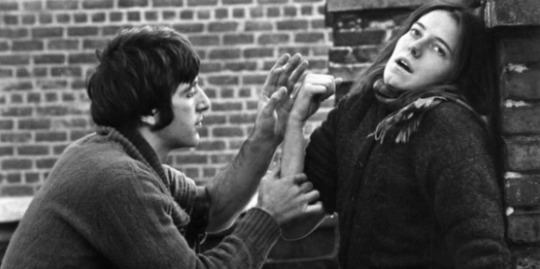
Rudin and Lindsay’s efforts were ultimately unsuccessful. Johnny Carson continued to roast the city—especially after escaping it when The Tonight Show relocated to Burbank, California in 1972—and prime-time comedies like All in the Family, Taxi, and Welcome Back, Kotter mined similar veins of urban unrest. Meanwhile, gritty crime series from Kojak to Cagney & Lacey to The Equalizer presented a similar picture of the city—dirty, grimy, and dangerous—to that of films like Taxi Driver, The Taking of Pelham One Two Three, The Warriors, and Fort Apache, The Bronx.
But in the 1990s, that all changed. And there’s a compelling case to be made that the change began with Jerry Seinfeld.
*

If we talk about Jerry Seinfeld, of course, we have to talk about Woody Allen, and not just their obvious similarities (roots in stand-up comedy, neurotic Jewish New Yorker persona, tabloid mainstay). In the 1970s and 1980s, while most New York movies were dwelling in the horrors and shortcomings of the city, Allen insulated himself in his upper-class Upper East Side neighborhood and made movies about people who were mostly untouched by crime, homelessness, and graffiti. In films like Annie Hall, Manhattan, Hannah and Her Sisters, and Crimes and Misdemeanors, Allen’s characters sip wine and trade hard truths and pointed witticisms at the city’s finest restaurants, parties, and apartments as the city burns around them; in Manhattan (which, by its own opening monologue admission, romances the city “all out of proportion”) he even edited out a joke about muggings from a Central Park carriage ride sequence, so as not to spoil the delicate mood. Allen’s New York was “not another world,” Martin Scorsese once said. “It’s another planet.”
That vision of New York—upper-crust, erudite, sophisticated—wasn’t entirely absent from the big and small screen in the ‘70s and ‘80s, thanks to films like An Unmarried Woman and Kramer Vs. Kramer, and such TV shows as Diff’rent Strokes and The Cosby Show. But Allen’s films, and even more so Rob Reiner and Nora Ephron’s Allen-esque When Harry Met Sally (a far bigger commercial success than any of Woody’s work), created a vision of comfortable, upscale, wise-cracking New York living that would reach a mass audience via Seinfeld, which debuted in 1989.
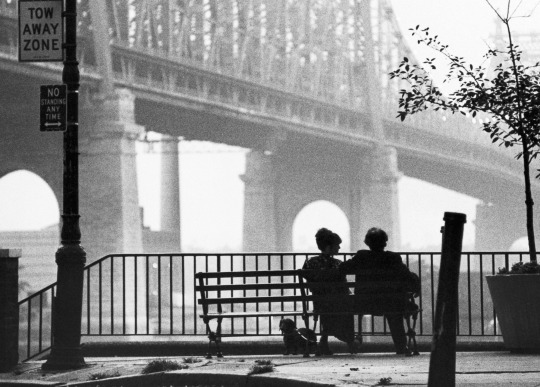
The first two brief seasons of Seinfeld (or, as it was originally titled, The Seinfeld Chronicles) struggled in the ratings, but it slowly built an audience and climbed in the Nielsens, and by season five (1993-1994) it was one of the top five shows on the air, anchoring NBC’s “Must See TV” line-up of Thursday night sitcoms. In September 1994, it was joined on Thursdays by another comedy, in which urbane New York pals joked, dated, and shared the horrors of city living. Friends, however, was a rating smash right away, and not only because of its killer schedule placement. It sanded away the rougher edges of Seinfeld; its characters were more likable (or, at least, intended to be), and its humor was less spiky. It ran even longer than Seinfeld, ten seasons, every one of them in the top ten, all but one in the top five.
*
Even as these New York comedies—and others that followed, like Mad About You, Caroline in the City, and The Single Guy—were topping the ratings, the face of the city was changing. “Don’t forget to in the late ’80s, you came off of a couple of financial crises, some bad times,” explains agent Chris Fry, of Elegran Real Estate. ”It was a little bit more affordable, things were dropping. And I think the shows that you’re talking about definitely had a positive effect on what people perceived New York City to be.”
Crime was on the decline across the country, but especially in New York City, a drop that began under Mayor David Dinkins and continued under Rudy Giuliani. The latter, in coordination with NYPD commissioner William Bratton, instituted an aggressive policy of enforcing so-called “quality of life” crimes like graffiti, turnstile-jumping, and panhandling; this philosophy, modeled on James Q. Wilson and George L. Kelling’s controversial “broken windows” theory, held that if these comparatively minor yet highly visible crimes were eradicated, the city would look clean and controlled, and thus psychologically discourage a lawlessness that would result in fewer serious offenses like murder, rape, and theft.
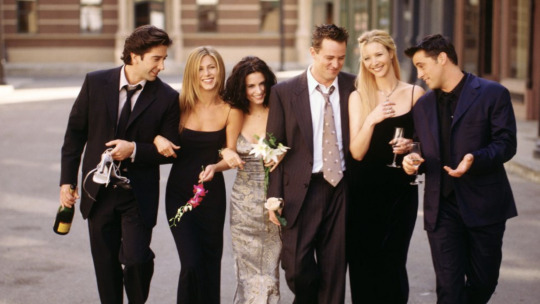
This vision of the city was certainly reflected in NBC’s Thursday night lineup. The early ‘90s comedies found fodder in the minor inconveniences of city life, but rarely trod into the seediness and crime that defined such earlier sitcoms as Night Court and Barney Miller. Paul and Jamie Buchman’s apartment wasn’t burglarized; none of the Friends were mugged in Central Park. When a blackout hit New York City in the summer of 1977, there were over one thousand fires, over 1500 damaged and/or looted stores, and nearly four thousand arrests. When a blackout hit NBC’s Thursday night New York City in the fall of 1994, Chandler Bing got trapped in an ATM vestibule with a supermodel.
If these sitcoms were the television reflection of the “broken windows” theory, their creators had a much easier time cleaning up New York City—in part because they weren’t shooting in it. Much like the films set in New York City before Mayor Lindsay established the Mayor’s Office of Film, Theatre, and Broadcasting, all of these series were shot on soundstages and backlots in California, with the exception of the occasional second-unit exterior establishing shot. So they took place in New York City, but the version of New York City they presented was highly fictionalized. Just as Paul and Jamie, Jerry and the gang, and the Central Perk crew were funnier and sharper than real New Yorkers (and lived in apartments far beyond their means), the New York they lived in was squeakier and clearer.
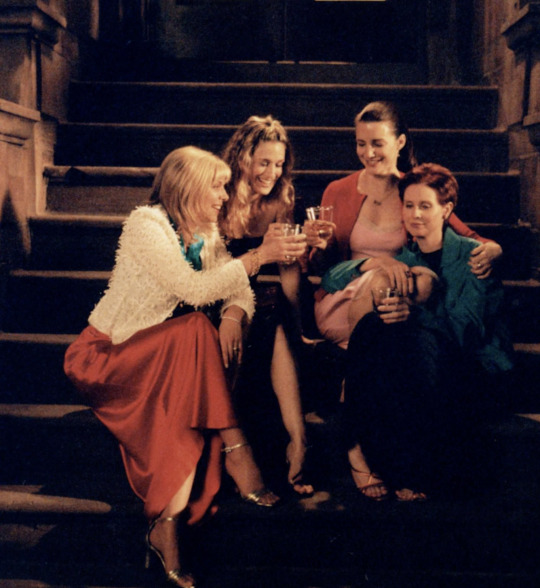
“I love Friends,” says Sire Leo Lamar-Becker, who was inspired by the shows of the ‘90s to leave California and move to New York, where he currently works in the fashion industry. “But Friends was so sterile. It didn’t feel real. And what Sex and the City offered was, I felt, a more nuanced portrayal of the city.”
Like the New York movies from the late 1960s onward, Sex and the City had the advantage of authenticity: It was shot entirely in New York, the exteriors and the sets (constructed and filmed at Silvercup Studios) and everything in between. “If you’re familiar with this series, and the movies, the city is integral to it,” explains tour guide Lou Matthews. “They've called it, like the fifth girl is the city. It's really crucial.” As a guide for the “Sex and the City Hotspots Tour,” which On Location Tours has conducted since 2001, Matthews has seen, firsthand, the psychological effect of that particular show.
“I've definitely met girls in their twenties, or maybe they’re still in college, on the tour who are saying, ‘Yeah, I fell in love with Sex in the City and New York City because of Sex in the City. And like, I’m already trying to figure out how I can get a job here.’ And then I’ve definitely met a few where the reason they moved here was because of Sex in the City, like they wanted the life that Carrie has. And here they are.”
The life they found was, in most cases, not exactly what these shows promised. “As someone who has lived here for 10 years,” laughs Lamar-Becker, “sure, there are some things that are unrealistic—like, Carrie being able to afford all her shoes. That’s unrealistic. But the feeling of the city is always captured well.”
And that indefinable but unmistakable quality, that feeling of the city, is what’s shifted most over the past quarter-century or so – through Seinfeld and Friends and Sex and the City into 30 Rock and Gossip Girl and Girls, through When Harry Met Sally and You’ve Got Mail to The Devil Wears Prada, Trainwreck, and even The Avengers. Some of that shift in public perception is merely a reflection of reality, of filmmakers and show-runners pointing their cameras at the city and capturing the gentrified, yuppified, Disney-fied mutation it’s become.

But some of that is also life imitating art. Every day, Lou Matthews’s tour bus is filled with people like Sire Leo Lamar-Becker, members of a generation of viewers whose impressions of New York were formed not by Taxi Driver and Kojak, but by the Sex and the City films and Netflix binges of Friends. They watched those shows and memorized those movies, and then migrated to New York City like so many immigrants before them. Their predecessors flocked to Ellis Island, lured by promises of a new world. These settlers came to the Magnolia Bakery, seeking not so much a new world as a better one, full of enviable careers, witty friends, and all the cosmos they could drink.
Lewis Rudin would have been proud.
#New York City#johnny carson#lewis rudin#abny#death wish#panic in needle park#little murders#the french connection#all in the family#taxi#taxi driver#welcome back kotter#the equalizer#cagney and lacey#the taking of pelham 1 2 3#the warriors#fort apache the bronx#seinfeld#woody allen#manhattan#hannah and her sisters#annie hall#crimes and misdemeanors#kramer vs kramer#an unmarried woman#martin scorsese#diffrent strokes#the cosby show#friends#sex and the city
5 notes
·
View notes
Text
What-If Verne Gagne Made Hulk Hogan Champion?
The Era of The Territories died before I was born. There’s pros and cons to their execution. Up until Vince McMahon gobbled up the industry like Pac-Man devouring dots there were multiple regional territories with their own established stars. The Carolinas has Ric Flair. Tennessee has Jerry “The King” Lawler. Texas featured the Von Erichs. They would run their respective territories, sometimes wander beyond and do inter-promotional programs typically ending in disqualifications to save face. Back in those days, before television really changed the landscape, promoters could getaway with jerking around their fans with constant indecisive finishes. Chances are the people who paid the ticket price to see the action were the only ones who are ever going to see it.
Ever heard of “The Dusty Finish,” well get a load of what Verne Gagne of the American Wrestling Association put his customers through in the early eighties. Gift wrapped Hulk Hogan after Vince Sr canned the star for appearing in the film “Rocky III” Verne took the young Hogan under his wing teaching him almost all of what would make him the monolith he’d become. Gagne told Hogan to not drop down after one drop kick. Telling him it should take three or more to take him off his legs. Gagne molded Hogan into a monster in the ring. Initially, Hulk was supposed to be a featured heel like during his days in the WWF. But his charisma compounded by his cameo in “Rocky III” endeared him to fans of the Minneapolis based wrestling promotion. And in a few short months Hogan found himself in the title picture feuding with the long toothed, well read heel Nick Bockwinkel.
Bockwinkel had entered his fifties earlier in the 1980s, but you couldn’t have guessed his age if you only watched him in the ring. He always kept himself in tip-top shape, didn’t party all night like Ric Flair. He was a clean cut, midwestern man who Verne still entrusted to safeguard his companies most prized possession even late into his career. Bockwinkel before Hogan and after had great matches I highly recommend you check out. Preferably his one-hour marathon against a young, babyface, Curt Hennig. Yeah. Mr. Perfect was once in the AWA. So was “Mean Gene” Okerlund. Bobby “The Brain” Heenan. Scott Hall. Wendi Richter. Jesse Venture. All would become heavily featured players in the WWF/WCW when NWA fizzled.
Though Hogan was the star, and his current champ Bockwinkel was nearing fifty, Verne was hesitant - and later would outright say he didn’t see the 29-year-old as championship material or a prop he didn’t even need. Either Verne is lying or he poorly read the changing wrestling with the invention of television. The era of the babyface chasing the dastardly heel forever and ever was over. Promoters needed to shift towards more decisive finishes and book accordingly or face the same consequences Verne swallowed which squashed his once flourishing company. It’s quite the tragedy too. Verne knew his wrestling and could spot talent. Same could be said about Dusty Rhodes. At the end of the day what carries you over in a wrestling war isn’t talent, but business-savvy.
In his better days, McMahon knew sometimes it was better to go with what the fans wanted rather than persist with what he thought was right. He pulled the shoot on The Ultimate Warrior, ultimately giving way to the rise of Bret Hart, and Shawn Michaels. He later would do the same in the late-90s with “Stone Cold” Steve Austin. Neither were Vince’s cup of tea in what he perceived as championship material, but what mattered to him most was the all mighty dollar. But old Verne wasn’t as flexible and never really was. Come April 1983 he knew the long-standing Hogan/Bockwinkel had run its course and it was time to bestow the honor of champion to the younger star. Problem was, Verne couldn’t see beyond Hulk was a power wrestler, not too big on finesse and mat-style which was the makeup of the AWA. There’s also elements in this story that make Verne come off as a shitty, grubby businessman, and a downright creep. First, he demanded the bulk of Hogan’s merchandising sales (Hogan was printing his “Hulkamania” shirts and selling them outside of a trunk during House Shows) and his money he made wrestling for Japan; even though Verne had nothing to do with that promotion.
Actually, there might be some logic in Verne wanting a substantial cut in the money Hogan made overseas. See, he wrestled for a promotion called New Japan Pro-Wrestling. Verne had a partnership with a man named Shohei Baba — he would wrestle under the synonym “Giant Baba.” Baba worked as a promoter of All Japan Pro-Wrestling. The chief competitor of NJPW. Verne probably figured if he could squeeze Hogan for his NJPW paycheck he’d kick it to Giant Baba and subsequently AJPW and undercut the other promotion in the process.
The logic in Verne wanting the money though is nonexistent. Like McMahon when The Rock left the WWF to takeover Hollywood, he saw it fit to demand a chunk of his talent’s paycheck. Why? Because Vince McMahon made The Rock. Everyone knows that! Except he didn’t. The Rock made The Rock. In the wrestling world it doesn’t matter whether the boss acknowledged your existence before you made it big. All that mattered was he signed you to your deal and deserves the credit for those long hours you put in to climbing the ladder. Forget the fact that if it were up to Vince The Rock would have never turned heel, join The Nation of Domination and save his fledgling career.
I guess Verne can feel a little more secure in his belief he made Hogan into what he became. After all, he did instill the in-ring tactics that would carry him to superstardom. Regardless, the money Hogan made working NJPW was his, and it wasn’t like the AWA wasn’t doing gangbusters at House Shows and well in the black thanks to him.
The creepy aspect of this story was Verne was trying to set Hogan up with his daughter. Why? Well, he viewed the AWA as a family business and for whatever reason he didn’t trust his son, Greg, to succeed him so to keep the promotion in the family he wanted his champion to marry into it. You don’t believe me? In 1988 Larry Zbyszko marries Verne’s daughter. In February of ‘89 he wins the vacant AWA title in a Battle Royal.
It’s dysfunction like this is how you get an atmosphere like the one in the St. Paul Civic Center, the crowd absolutely becomes unglued as “Eye of the Tiger” roars through the speakers as the beach blonde haired heroine marches down the isle filled with purpose. He wears a black shirt that says “We Want The Belt” and on the back “Now Or Never.” You don’t get more prophetic than that last statement. Now or Never, Verne, and he chose Never. Hogan didn’t win the strap that night in St. Paul, and would soon leave the AWA. While the promotion enjoyed a few successful years before going defunct in 1991, you can trace their fall to “Super Clash” nine-years before.
So what-if Verne wasn’t a character out of a Leon Trotsky Socialist manifesto novel? What-if he just let Hogan keep his money and gave him the belt? Would the AWA still be around today? Hard to say, but I’m going to veer on the side of no. Hogan parading around with the AWA strap isn’t going to deter Vince from courting Hogan. We’re talking about the man who tried to convince Harley Race to no-show Starrcade ‘83 and take the NWA belt to his promotion.
One of the few ways Verne and the territories could have kept the bad wolf of New York from their doors was if they handed together to take him on. But nobody took the threat seriously until it was too late to sufficiently combat it. Another scenario is Ted Turner up and buys AWA with the NWA to form WCW. Having Turner on the wrestling scene against Vince was like Godzilla vs Mothra. WCW only started turning rotten when the Time Warner/AOL merger pushed Turner out of an influential role with the company. A more feasible scenario is Verne and Greg simply accept Vince’s offer he made at the St. Paul airport before turning around and exclaiming “I don’t negotiate”. But, if they did merge with the WWF the fate of the AWA is probably similar to Stu Hart and his Stampede Wrestling promotion. Their talent pool would be severely depleted and the promotion transforming from something that is on par — if not superior to the WWF to nothing more than a minor league farm system for New York to routinely pluck talent from.
If Hulk Hogan of all people suddenly become the most loyal person in the business and remained a stalwart of the AWA he arguably has a greater cast of heels to run through than he did in his first run as champion in the WWF. Stan Hansen, Leon White (A.K.A Vader), Larry Zbyszko, Curt Hennig, Jerry Lawler. While it’s highly questionable whether Hansen and Lawler would be willing to job to Hogan because of their value to other promotions, their feuds still print money at the gates and perhaps fans are just so happy to see Hogan as champion they don’t mind the constant string of D.Q finishes.
What does McMahon do? Rumor was his second choice was Paul Orndorff. A very good, if not great heel wrestler that is commonly forgotten due to the fact he jobbed to Hogan throughout the eighties. But Vince is more creative than that. He had to have an ace up his sleeve of Hogan alluded his grasps. Ric Flair? The Von Erichs? Maybe he pulls the trigger and makes Roddy Piper or Ricky Steamboat champion? Steamboat was only 31 by the time Iron Sheik beat Bob Backlund for the belt to set the table for Hogan. But Vince didn’t like skinny, short guys as his main champion. It’s why you see wrestlers like Daniel Bryan constantly marginalized despite showing time after time he can main event.
The AWA gave the wrestling world countless stars that would make this article too long if I were to list them all. But, like most promoters in the territory era, Verne had a limited grasp on how to maximize his profits and couldn’t see behind his own biases and greed.
#AWA#Wrestling#Hulk Hogan#Nick Bockwinkel#Verne Gagne#Vince McMahon#WWF#WWE#NWA#1980s#Minnesota#St.Paul#AWA Super Sunday#what if#alternate universe#free coinage of silver
1 note
·
View note
Text
A Song of Pain and Sorrow!
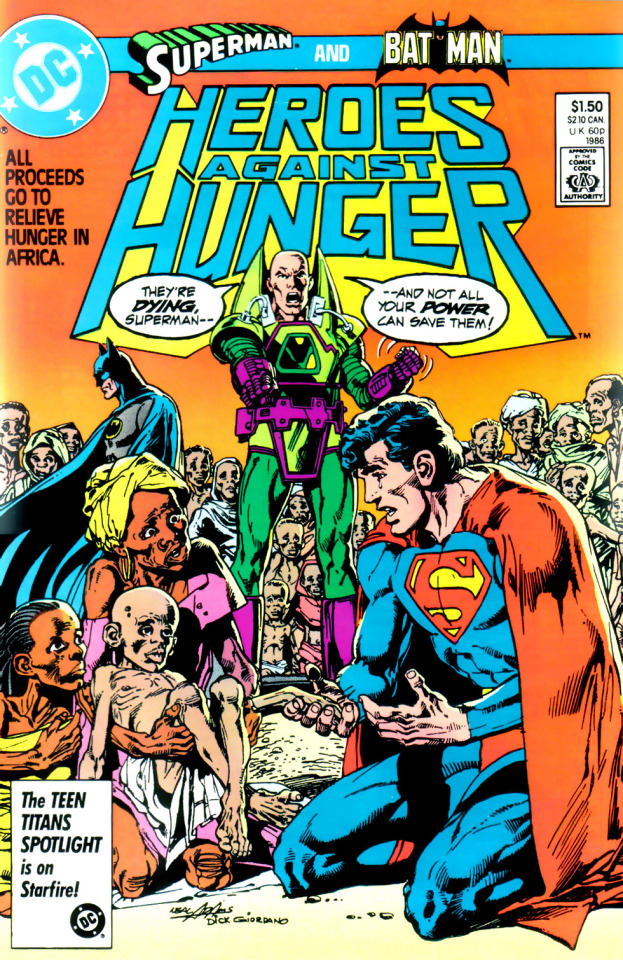
HEROES AGAINST HUNGER
1986
BY JIM STARLIN, CARY BATES, ELLIOT S. MAGGIN, PAUL LEVITZ, MIKE W. BARR, MICHAEL FLEISHER, BOB ROZAKIS, ROY THOMAS, J. M. DEMATTEIS, ROBERT BLOCH, ROBERT LOREN FLEMING, MARV WOLFMAN, TONY ISABELLA, GERRY CONWAY, BARBARA RANDALL, ANDREW HELFER, DAN MISHKIN, LEN WEIN, ED HANNIGAN, MINDY NEWELL, STEVE ENGLEHART, JOEY CAVALIERI, PAUL KUPPERBERG, DOUG MOENCH...
GEORGE PEREZ, PARIS CULLINS, DENYS COWAN, JAN DUURSEMA, KEITH GIFFEN, ROSS ANDRU, JOSÉ LUIS GARCÍA-LOPEZ, CARMINE INFANTINO, MARSHALL ROGERS, BERNIE WRIGHTSON, JOE BROZOWSKI, SAL AMENDOLA, CURT SWAN, BARRY WINDSOR-SMITH, ERNIE COLON, WALT SIMONSON, EDUARDO BARRETO, DAVE GIBBONS, JACK KIRBY, TONY SALMONS, DAN JURGENS, JOE KUBERT, DAVID ROSS, JIM SHERMAN...
KIM DEMULDER, TONY DEZUNIGA, VAL MAYERIK, ALFREDO ALCALA, JOE STATON, KLAUS JANSON, JERRY ORDWAY, MURPHY ANDERSON, KARL KESEL, MIKE KALUTA, GRAY MORROW, JIM APARO, JOHN BYRNE, JEFF JONES, TERRY AUSTIN, STEVE LEIALOHA, ROMEO TANGHAL, BRUCE PATTERSON, AL MILGROM, TOM MANDRAKE, BILL WRAY, JOE RUBINSTEIN, HOWARD CHAYKIN, GREG THEAKSTON, ALAN WEISS...
DAINA GRAZANUS, MICHELE WOLFMAN, GENE D’ANGELO, CARL GAFFORD, ANTHONY TOLLIN, TOM ZIUKO, GEORGE ROBERTS, LIZ BERUBÉ, NANSI HOOLAHAN AND TATJANA WOOD
SYNOPSIS (FROM COMIC VINE)
Superman delivers an acre of top soil to Ethiopia. A sirocco threatens to blow away the top soil, but Superman's quick actions save the majority of it. Lee Ann Layton, a member of the Peace Corps, casts doubt on Superman's ability to truly change Ethiopia for the better. Superman carries out his task to pepper the Ethiopian landscape with acres of top soil. The top soil is blasted out of Superman's hands. Miles away, Batman investigates the crash of an airplane, which was delivering food to Ethiopia. Seeing Superman flying overhead, Batman signals the Man of Steel to join his investigation.
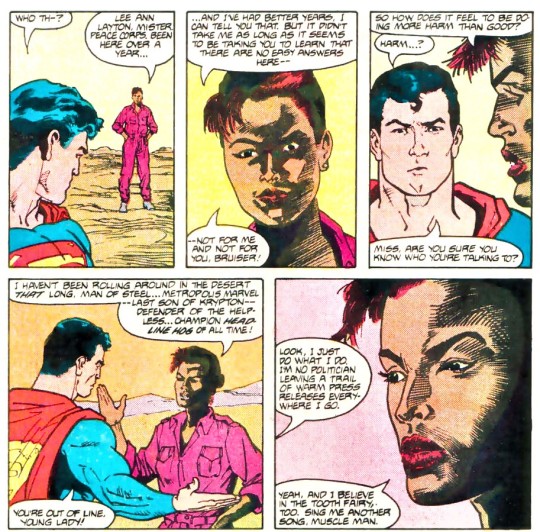
A cursory glance with his microscopic vision reveals that a particle beam brought the plane down. Superman tasks Batman with enlisting the aid of Superman's nemesis, Lex Luthor. Batman tasks Superman with discovering how their unknown foe knows the schedules of the famine relief planes. Superman's investigation brings him into conflict with a trio of androids, which Superman destroys. Superman traces a broadcast signature to an alien craft, buried miles beneath Ethiopia. Superman confronts the Master, an alien that feeds off hopelessness and entropy.
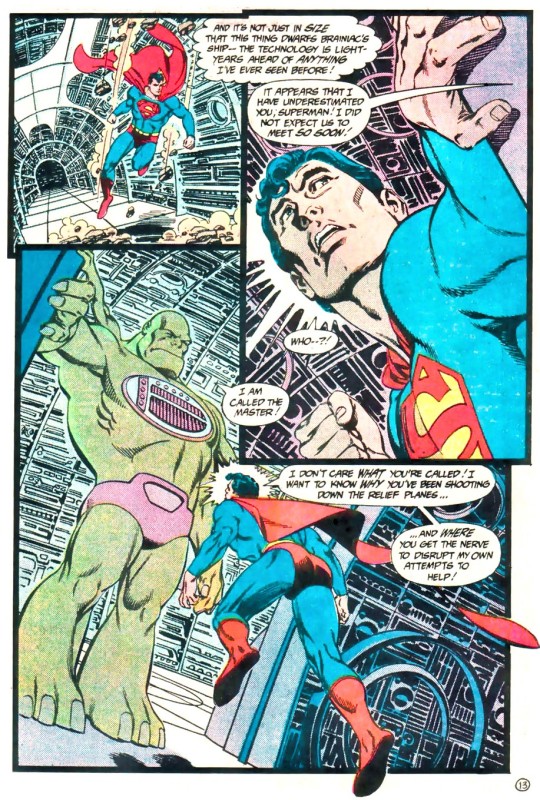
Superman battles the Master, only to find himself teleported away, back to the surface. Batman storms Luthor's island base. Batman confronts Luthor. Batman convinces Luthor to use his plant growth formula to aid Ethiopia. Luthor only consents to prove his superiority over Superman. Batman, and Luthor, rendezvous with Superman. Suddenly their surroundings are plunged into pitch, as the entire planet is encased in a sphere of total darkness. With the Earth completely cut off from the light of the Sun, all life on Earth is in jeopardy.

Luthor locates the Master's ship, just outside of a refugee camp for famine victims. Luthor is visibly shaken by his encounter with the starving children. Luthor tasks Batman with evacuating the camp. Luthor teams up with Superman to confront the Master. The Master teleports Superman into another dimension. Luthor attacks the Master, who grows stronger feeding off Luthor's despair. Layton chastises the Batman for placing the camp in danger. Batman races to the Master's ship to render assistance. Superman flies faster than the speed of light to escape the Master's dimension of abject darkness.

Playing the instrument lodged in his chest, the Master releases four fireballs, each threatening a different city. Superman is forced to abandon Luthor, to deal with the new threat. Superman dissipates the fireballs. Luthor continues his desperate battle against the Master. Batman joins the fight. Luthor projects a force field around the Master's destructive instrument, preventing the Master from playing it. Nonetheless, the Master closes on Luthor, intent on crushing the life from him with his bare hands. Superman intervenes, and beats the Master into submission.


Superman wrenches the instrument from the Master's chest, then hurls the Master into the dimension of darkness. With the threat of the Master ended, Superman works with Luthor to end the famine in Ethiopia. Luthor's plant growth formula, however, fails. What worked on Luthor's world, Lexor, is incompatible with the soil composition of Earth. Layton explains that it took man years to turn Ethiopia into a desert, and a single afternoon of super-heroic efforts was never going to restore it. Layton states that it will take a concerted effort, on the part of the entire world, to save the African continent. As Batman, Luthor, and Superman depart, Layton allows herself to feel hope for the future.


BEHIND THE SCENES

1983-1985 FAMINE IN ETHIOPIA (FROM WIKIPEDIA)
A widespread famine affected Ethiopia from 1983 to 1985. The worst famine to hit the country in a century, in northern Ethiopia it led to more than 400,000 deaths, but, according to Human Rights Watch, more than half its mortality could be attributed to "human rights abuses causing the famine to come earlier, strike harder and extend further than would otherwise have been the case". Other areas of Ethiopia experienced famine for similar reasons, resulting in tens of thousands of additional deaths. The famine as a whole took place a decade into the Ethiopian Civil War.
The famine of 1983–85 is most often ascribed to drought and climatic phenomena. However, Human Rights Watch has alleged that widespread drought occurred only some months after the famine was under way. According to the organisation, and Oxfam UK, the famines that struck Ethiopia between 1961 and 1985, and in particular the one of 1983–85, were in large part created by government policies, specifically a set of so-called counter-insurgency strategies and "social transformation" in non-insurgent areas.
The economy of Ethiopia is based on agriculture: almost half of GDP, 60% of exports, and 80% of total employment come from agriculture.
In 1974, a group of Marxist soldiers known as the Derg overthrew the government. The Derg addressed the Wollo famine by creating the Relief and Rehabilitation Commission (RRC) to examine the causes of the famine and prevent its recurrence, and then abolishing feudal tenure in March 1975. The RRC initially enjoyed more independence from the Derg than any other ministry, largely due to its close ties to foreign donors and the quality of some its senior staff. As a result, insurgencies began to spread into the country's administrative regions
By late 1976 insurgencies existed in all of the country's fourteen administrative regions. The Red Terror (1977–1978) marked the beginning of a steady deterioration in the economic state of the nation, coupled with extractive policies targeting rural areas. The collapse of the system of State Farms, a large employer of seasonal laborers, resulted in an estimated 500,000 farmers in northern Ethiopia losing a component of their income. Grain wholesaling was declared illegal in much of the country, resulting in the number of grain dealers falling from between 20,000 and 30,000 to 4,942 in the decade after the revolution.
The nature of the RRC changed as the government became increasingly authoritarian. Immediately after its creation, its experienced core of technocrats produced highly regarded analyses of Ethiopian famine and ably carried out famine relief efforts. However, by the 1980s, the Derg had compromised its mission. The RRC began with the innocuous scheme of creating village workforces from the unemployed in state farms, and government agricultural schemes but, as the counter-insurgency intensified, the RRC was given responsibility for a program of forced resettlement and villagization. As the go-between for international aid organizations and foreign donor governments, the RRC redirected food to government militias, in particular in Eritrea and Tigray. It also encouraged international agencies to set up relief programs in regions with surplus grain production, which allowed the AMC to collect the excess food. Finally, the RRC carried out a disinformation campaign during the 1980s famine, in which it portrayed the famine as being solely the result of drought and overpopulation and tried to deny the existence of the armed conflict that was occurring precisely in the famine-affected regions. The RRC also claimed that the aid being given by it and its international agency partners were reaching all of the famine victims.
Four Ethiopian provinces—Gojjam, Hararghe, Tigray and Wollo—all received record low rainfalls in the mid-1980s. In the south, a separate and simultaneous cause was the government's response to Oromo Liberation Front (OLF) insurgency. In 1984, President Mengistu Haile Mariam announced that 46% of the Ethiopian Gross National Product would be allocated to military spending, creating the largest standing army in sub-Saharan Africa; the allocation for health in the government budget fell from 6% in 1973–4 to 3% by 1990–1.
Although a UN estimate of one million deaths is often quoted for the 1983–5 famine, this figure has been challenged by famine scholar Alex de Waal. In a major study, de Waal criticized the United Nations for being "remarkably cavalier" about the numbers of people who died, with the UN's one-million figure having "absolutely no scientific basis whatsoever," a fact which represents "a trivialization and dehumanization of human misery.". De Waal estimates that 400,000 to 500,000 died in the famine.
Nevertheless, the magnitude of the disaster has been well documented: in addition to hundreds of thousands of deaths, millions were made destitute. Media activity in the West, along with the size of the crisis, led to the "Do They Know It's Christmas?" charity single and the July 1985 concert Live Aid, which elevated the international profile of the famine and helped secure international aid. In the early to mid-1980s there were famines in two distinct regions of the country, resulting in several studies of one famine that try to extrapolate to the other or less cautious writers referring to a single widespread famine. The famine in the southeast of the country was brought about by the Derg's counterinsurgency efforts against the OLF. However, most media referring to "the Ethiopian famine" of the 1980s refers to the severe famine in 1983-85 centered on Tigray and northern Wollo, which further affected Eritrea, Begemder and northern Shewa. Living standards had been declining in these government-held regions since 1977, a "direct consequence" of Derg agricultural policies. A further major contributing factor to the famine were the Ethiopian government's enforced resettlement programs, utilized as part of its counter-insurgency campaign.
Despite RRC claims to have predicted the famine, there was little data as late as early 1984 indicating an unusually severe food shortage. Following two major droughts in the late 1970s, 1980 and 1981 were rated by the RRC as "normal" and "above normal". The 1982 harvest was the largest ever, with the exception of central and eastern Tigray. RRC estimates for people "at risk" of famine rose to 3.9 million in 1983 from 2.8 million in 1982, which was less than the 1981 estimate of 4.5 million. In February and March 1983, the first signs of famine were recognized as poverty-stricken farmers began to appear at feeding centers, prompting international aid agencies to appeal for aid and the RRC to revise its famine assessment. The harvest after the main (meher) harvest in 1983 was the third largest on record, with the only serious shortfall again being recorded in Tigray. In response, grain prices in the two northern regions of Begemder and Gojjam fell. However, famine recurred in Tigray. The RRC claimed in May 1984 that the failure of the short rains (belg) constituted a catastrophic drought, while neglecting to state that the belg crops form a fourth of crop yields where the belg falls, but none at all in the majority of Tigray. A quantitative measure of the famine are grain prices, which show high prices in eastern and central Tigray, spreading outward after the 1984 crop failure.
A major drain on Ethiopia's economy was the ongoing civil war, which pitched rebel movements against the Soviet and Cuban backed Derg government. This crippled the country's economy further and contributed to the government's lack of ability to handle the crisis to come.
By mid-1984, it was evident that another drought and resulting famine of major proportions had begun to affect large parts of northern Ethiopia. Just as evident was the government's inability to provide relief. The almost total failure of crops in the north was compounded by fighting in and around Eritrea, which hindered the passage of relief supplies. Although international relief organizations made a major effort to provide food to the affected areas, the persistence of drought and poor security conditions in the north resulted in continuing need as well as hazards for famine relief workers. In late 1985, another year of drought was forecast, and by early 1986 the famine had spread to parts of the southern highlands, with an estimated 5.8 million people dependent on relief food. In 1986, locust plagues exacerbated the problem.
TL;DR
The famine was caused by a series of events, most of them of politic nature (and the cold war didn’t help). But apart from the human causes, the region has been suffering draughts for a long time (and still does), ruining Ethiopia’s main industry.
AID (FROM BBC)
BBC's Michael Buerk achieved something very rare - he not only reported the world, but changed it a little bit.
His vivid on-the-spot coverage of a famine "of biblical proportions" in Tigray in northern Ethiopia pricked the conscience of the richer part of the world.
The money came pouring in. Bob Geldof's Band Aid and Live Aid led the way in galvanizing public attention, raising cash and mobilizing a huge relief effort.
As a result, many thousands of lives were saved - and tens of thousands of those facing starvation received food.
BBC World Service has broadcast an Assignment documentary based on the testimony of key figures on the ground in and around Tigray in the mid-1980s. Presenting evidence, that some of the famine relief donations were diverted by a powerful rebel group to buy weapons.
The documentary has revealed some uncomfortable facts and provoked a strong response. This morning a British newspaper, The Independent, gives over its front page to complaints from Bob Geldof and several leading charities. They accuse the BBC of "disgracefully poor reporting".
This documentary was put together by Martin Plaut, Africa Editor at BBC World Service News. He has a particular expertise in the Horn of Africa, and indeed reported from there on the famine back in the 1980s. He has spent almost a year gathering material and doing research for this documentary - and the BBC stands by his journalism.
As so often is the case, the famine that afflicted northern Ethiopia was compounded by war. Much of Tigray was controlled by a hard left-wing rebel group, the Tigrayan People's Liberation Front. They were fighting the Ethiopian army, then the largest in Africa. This was also the era of the cold war - and the Americans were seeking to undermine the Soviet-aligned Ethiopian government.
It is not in dispute that millions of dollars of relief aid was channelled through the Relief Society of Tigray (Rest), which was a part of the TPLF rebel movement. It was the only way of reaching those in desperate need in rebel-held areas. What Martin Plaut's documentary uncovers is the systematic diversion of aid received by Rest to buy arms for the TPLF.
Martin tracked down two key former members of the TPLF who explained how they managed to divert the money.
They are now at odds with the then TPLF leader, Meles Zenawi, who is currently Ethiopia's Prime Minister. But they are credible voices.
One of these former TPLF fighters, the rebel army commander at the time, makes an allegation which has attracted particular controversy - that the organisation made a policy decision that only 5% of the money received by Rest would be spent on relief, with the bulk going directly or indirectly to support their military and political campaigns.
Among the other accounts featured in the World Service programme, Robert Houdek, who was the senior US diplomat in Ethiopia in the late 1980s, states that TPLF members told him at the time that some aid money and supplies was used to buy weapons. A CIA document paints the same picture.
Bob Geldof was given every opportunity to express his point of view while the documentary was being made, but declined to be interviewed.
Some relief agencies - including Christian Aid and Cafod - pointed us towards their staff involved in directing food supplies 25 years ago, and those voices were included.
Two key aid workers active in and around Ethiopia in the 1980s confirm in the BBC World Service programme the way in which relief was channeled through Rest - though they dispute that there was a significant diversion of money for arms buying.
"If we were being conned, I think it was on a very small scale," said Stephen King, then overseeing from Sudan the work of Catholic charities in providing food to the starving.
The documentary did not say that most famine relief money was used to buy weapons - it did not suggest that any relief agencies were complicit in the diversion of funds - it explicitly stated that "whatever the levels of deception, much aid did reach the starving".
But there is a clear public interest in determining whether some money given as famine relief ended up buying guns and bullets.
And that's what the evidence suggests.

REVIEW
So, if you paid attention to the story behind this book, it was done by pretty much the same people that did Heroes for Hope (Marvel’s version). Now, I’ll be very direct here, I think this one works better than Marvel’s.
Marvel’s version is too vague and abstract about the problem (there is one panel explaining how they weren’t responsible enough with trees).
In this book, even with a crazy super-villain involved, there is at least one explanation about the cause and what WE can do from our comfy homes. Which was the whole point of the campaign. Sure, in my quick research I couldn’t find any evidence that peanut crops were involved, but let’s just say that the book doesn’t spend too much time explaining the issues.
In fact neither of the two stories explain the ongoing civil war. There are at least some vague references to conflicts in the area in this book.
Luthor’s involvement was a nice touch. But just like with “Heroes for Hope”, here the heroes involved only make a glorified World’s finest issue.
The villain is there only to give the heroes an excuse to stay longer. I cannot say that story makes much sense, but it is pretty much the same motivation the villain had in Heroes for Hope.
But at least the three characters involved were Batman, Superman and Lex Luthor, and everyone knows these characters. So it is accessible.
The character of Lee Ann Layton... I am not sure if this is an actual real life person or what, but she should calm the fuck down a little!
She starts attacking Superman’s efforts, and pretty much anything they try to do because they are not bringing money. Lady, at least they are trying!
The art feels a bit more uniform in this book than in Marvel’s version. Perhaps because the artists involved were mostly from DC, with experience on these characters.
In the end, it is important to remember that the artists involved did this for free.
How successful was this comic-book? I never found the exact figures and no one recovered the comic book sales charts of the eighties yet. Maybe some day someone will tell us. In any case, if only 5% went to help the people, and the rest to keep them hungry, maybe it is best not to know.
I give this special a score of 6
#neal adams#dick giordano#heroes against hunger#dc comics#comics#review#1986#live aid#modern age#superman#batman#lex luthor#ethiopia#famine
10 notes
·
View notes